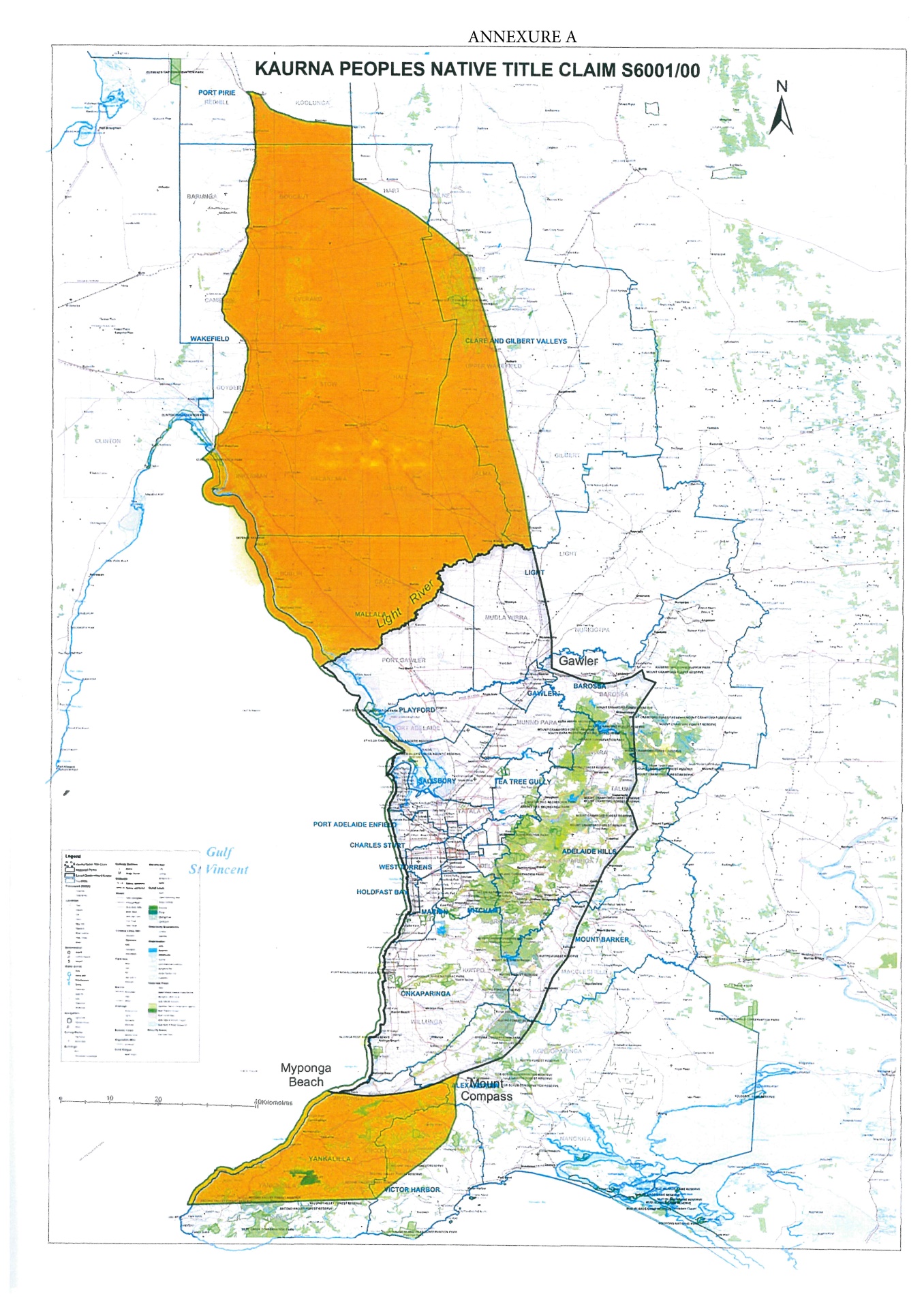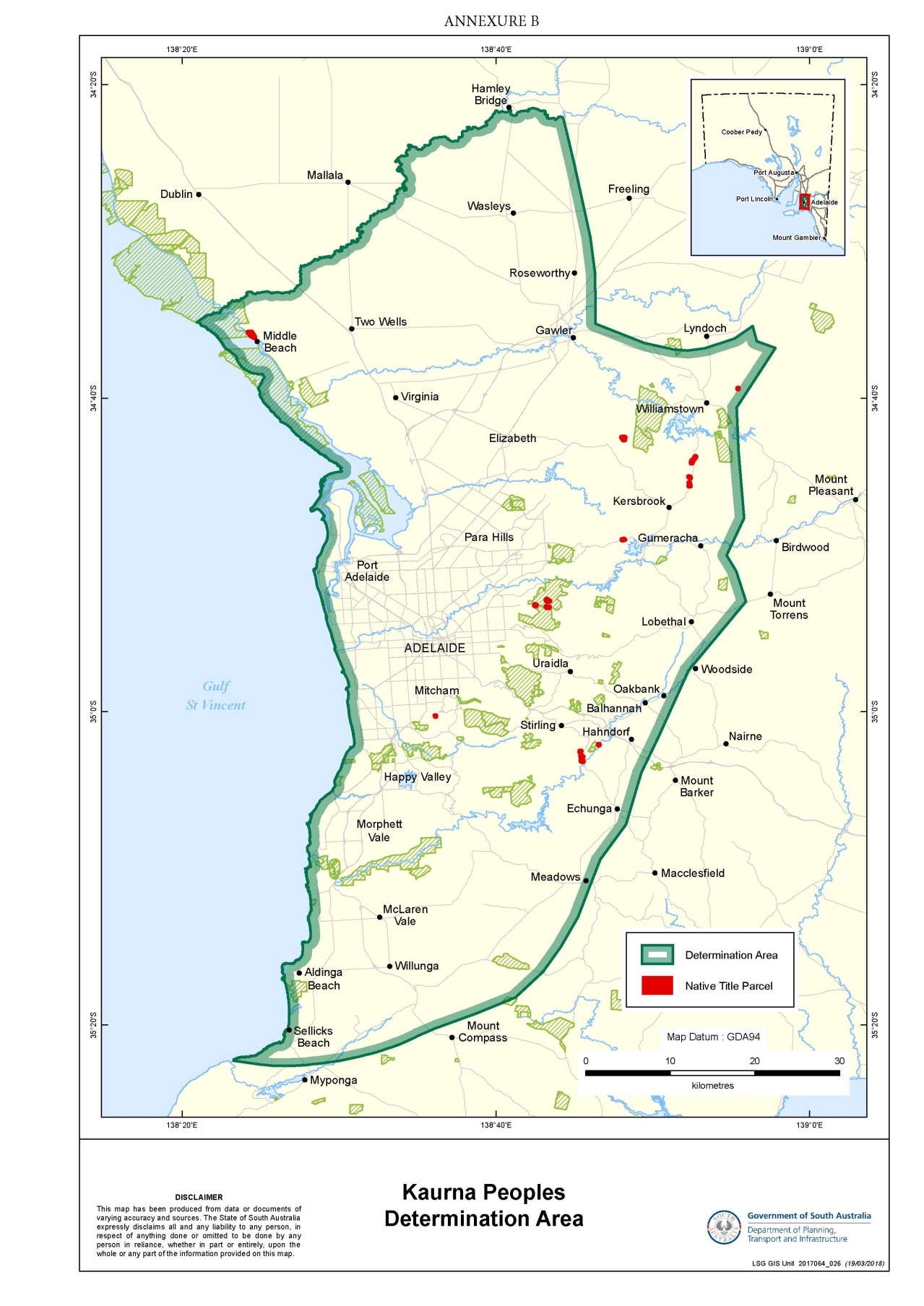FEDERAL COURT OF AUSTRALIA
Agius v State of South Australia (No 6) [2018] FCA 358
ORDERS
DATE OF ORDER: |
Preamble
1. Native Title Determination Application No. SAD 6001 of 2000 was first lodged with the Federal Court of Australia on 25 October 2000.
2. The Application was amended in the form of the document titled Minute of Proposed Amended Native Title Determination Claimant Application (Form 1) filed on 4 July 2001 and again on 7 March 2018 (Amended Application).
3. The matter was listed for trial to commence on 3 April 2018 to determine, as separate questions, whether native title exists in relation to any and what land and waters of the Kaurna claim area and, to the extent that it does, who are the persons, or each group of persons, holding the common or group rights comprising the native title and the nature and extent of the native title rights and interests.
4. The Applicant approached the First Respondent (State) with a view to agreeing to settle the Amended Application without the need to proceed with the trial. Both parties have negotiated in good faith and with full advice from their legal representatives, including counsel, and experts, and have reached a compromise which is set out in an Indigenous Land Use Agreement (Kaurna Peoples’ Settlement ILUA) and in this determination of native title. This determination will take effect upon the registration of the ILUA as an Area Agreement under Subdivision C of Division 3 of Part 2 of the Native Title Act 1993 (Cth) (NTA).
5. In negotiating the settlement, the State has borne in mind the fact that the original Aboriginal custodians of land in the Determination Area were affected in a unique way by the settlement of the Province of South Australia including the City of Adelaide and its surrounds and that the Applicant represents a group that has contemporary recognition by the State as representing those original inhabitants.
6. The parties, including the Applicant, the State and the other respondents have now reached an agreement as to the terms of a determination of native title to be made in relation to land and waters covered by the Amended Application and as to the terms of proposed orders.
7. The Applicant and the State have carried out a broad analysis of tenure and agree that, in respect of the overwhelming majority of the land and waters within the Determination Area, native title rights and interests have been extinguished. The tenure position reflected in this Determination represents a compromise that has been agreed between the parties for the purposes of settlement.
8. The parties acknowledge that, when the Determination takes effect, the members of the native title claim group, in accordance with the traditional laws acknowledged and the traditional customs observed by them, will be recognised as the Native Title Holders for the Native Title Land.
Being satisfied that a determination in the terms sought by the parties would be within the power of the Court and it appearing to the Court appropriate to do so:
THE COURT ORDERS THAT:
1. There be a Determination of native title in the Determination Area in the terms set out at paragraphs 6 to 19 below.
2. The Determination will take effect upon the ILUA being registered on the Register of Indigenous Land Use Agreements.
3. In the event that the ILUA is not registered on the Register of Indigenous Land Use Agreements within six (6) months of the date of this order, or such later time as the Court may order, the matter is to be listed for further directions.
4. The Applicant (prior to the Determination taking effect) or the Prescribed Body Corporate (after the Determination takes effect), the State and any other respondent have liberty to apply on 14 days’ notice to a single judge of the Court:
(a) if that party considers that the ILUA will not be registered on the Register of Indigenous Land Use Agreements within 6 months of the date of this order;
(b) to establish the precise location and boundaries of any Public Works and adjacent land and waters referred to in items 2 or 3 of Schedule 4;
(c) to determine the effect on native title rights and interests of any Public Works as referred to in item 3 of Schedule 4.
5. Each party to the proceeding is to bear its own costs.
THE COURT DETERMINES THAT:
Interpretation & Declaration
6. In this Determination, including its schedules:
(a) unless the contrary intention appears, the words and expressions used have the same meaning as they are given in Part 15 of the NTA;
(b) “Native Title Land” means the land and waters referred to in paragraph 9 of these orders; and
(c) in the event of an inconsistency between a description of an area in a schedule and the depiction of that area on the maps in Schedule 2, the written description shall prevail.
Determination Area
7. Schedule 1 describes the external boundaries of the determination area (Determination Area).
8. To the extent that the Amended Application concerns land and waters that are outside the Determination Area, it is dismissed.
Areas within Determination Area where native title exists (Native Title Land)
9. Subject to items 1, 2, 3 and 4 of Schedule 4, native title exists in the land and waters described in Schedule 3.
Areas within Determination Area where native title does not exist
10. Pursuant to s 225 of the NTA, native title does not exist in relation to all of the land and waters comprised in those areas described in Schedule 4.
Native Title Holders
11. Under the traditional laws and customs of the Kaurna People the Native Title Holders are those living Aboriginal people who are the descendants (including by adoption, as defined below) of the following apical ancestors:
(a) Kudnarto
(b) Father of Charlotte;
(c) Father of King Rodney, known as Williamy or Tairmunda;
(d) Nancy Mitchell;
(e) Rathoola;
(f) Mary Monarto (also known as Mary Wilkins or Nellie Raminyemmermin);
(g) Sam Stubbs;
(h) Agnes Waddick (also known as Agnes Horrocks or the mother of Augusta Horrocks);
(i) James Goldsmith;
(j) David Bews or Bewes;
(k) Mary McCarthy (sometimes known as Mary McCarty)
and are recognised by the other Native Title Holders under those traditional laws and customs as having rights and interests in the Determination Area (collectively, Native Title Holders).
In the foregoing, the words ‘including by adoption’ are intended to include as Native Title Holders:
(a) those Aboriginal persons, who were or are raised as children and as part of the families of any of the apical ancestors or their biological descendants; and
(b) descendants of the Aboriginal persons described in (a) above.
Rights and Interests
12. Subject to paragraphs 13, 14 and 15, the nature and extent of the native title rights and interests in the Native Title Land are rights to use and enjoy those lands and waters, being:
(a) the right of access to the land and waters;
(b) the right to live on, use and enjoy the land and waters including for ceremonial purposes;
(c) the right to take, use enjoy, share and exchange the resources of the land and waters including by fishing, hunting and gathering; but excluding those resources referred to in item 1 of Schedule 4;
(d) the right to conduct funerals and burials on the land and waters.
(e) the right to maintain and protect places of importance under traditional laws, customs and practices on the land and waters;
(f) the right to teach on the land and waters; and
(g) the right to be accompanied on the land and waters by those people who, though not Kaurna persons, are
(i) spouses of Kaurna persons; or
(ii) people required by the traditional laws and customs for the performance of ceremonies or cultural activities.
General Limitations
13. The native title rights and interests set out at paragraph 12 are for personal, domestic and communal use but do not include the right to trade in, or the commercial use of, the Native Title Land or the resources from it.
14. The native title rights and interests described in paragraph 12 do not confer possession, occupation, use and enjoyment of the land and waters on the Native Title Holders to the exclusion of others.
15. The native title rights and interests set out at paragraph 12 are subject to and exercisable in accordance with:
(a) the traditional laws and customs of the Native Title Holders; and
(b) the valid laws of the State and Commonwealth, including the common law.
Other Interests & Relationship with Native Title
16. The nature and extent of other interests in the Native Title Land are:
(a) the interests of the Crown in right of the State of South Australia;
(b) the interests of the Commonwealth of Australia, if any;
(c) in relation to reserves as defined in the National Parks and Wildlife Act 1972 (SA):
(i) the rights and interests of the Crown in right of the State of South Australia pursuant to the National Parks and Wildlife Act 1972 (SA); and
(ii) the rights and interests of the public to use and enjoy those reserves consistent with the National Parks and Wildlife Act 1972 (SA);
(d) interests of persons to whom valid or validated rights and interests have been granted or recognised by the Crown in right of the State of South Australia or by the Commonwealth of Australia pursuant to statute or otherwise in the exercise of executive power including, but not limited to, rights and interests granted or recognised pursuant to the Crown Land Management Act 2009 (SA), Crown Lands Act 1929 (SA), Native Vegetation Act 1991 (SA), Fisheries Management Act 2007 (SA), Natural Resources Management Act 2004 (SA), Mining Act 1971 (SA), and Petroleum and Geothermal Energy Act 2000 (SA), all as amended from time to time;
(e) rights or interests held by reason of the force and operation of the laws of the State or of the Commonwealth;
(f) the rights to access land by an employee or agent or instrumentality of the State, Commonwealth or other statutory authority as required in the performance of his or her statutory or common law duties where such access would be permitted to private land;
(g) the rights and interests of all parties to the Indigenous Land Use Agreement listed in Schedule 5 arising by reason of that agreement;
(h) the rights and interests of Telstra Corporation Limited (ACN 051 775 556):
(i) as the owner or operator of telecommunications facilities within the Native Title Land;
(ii) created pursuant to the Post and Telegraph Act 1901 (Cth), the Telecommunications Act 1975 (Cth), the Australian Telecommunications Corporation Act 1989 (Cth), the Telecommunications Act 1991 (Cth) and the Telecommunications Act 1997 (Cth), including rights:
1. to inspect land;
2. to install, occupy and operate telecommunications facilities; and
3. to alter, remove, replace, maintain, repair and ensure the proper functioning of its telecommunications facilities;
(iii) for its employees, agents or contractors to access its telecommunications facilities in and in the vicinity of the Native Title Land in performance of their duties; and
(iv) under any lease, licence, permit, access agreement or easement relating to its telecommunications facilities within the Native Title Land;
(i) the rights, interests and entitlements of SA Power Networks (a partnership of Spark Infrastructure SA (No.1) Pty Ltd, Spark Infrastructure SA (No.2) Pty Ltd, Spark Infrastructure SA (No.3) Pty Ltd, CKI Utilities Development Limited and PAI Utilities Development Limited) and its related and successor entities, including its rights, interests and entitlements:
(i) to exercise its entitlements and discharge its obligations as the owner and/or operator of electricity infrastructure (as defined in the Electricity Act 1996 (SA)) (Electricity Act) and telecommunications facilities and infrastructure within the Native Title Land including but not limited to the existing infrastructure identified in Schedule [6] (Existing Infrastructure);
(ii) to exercise its entitlements and discharge its obligations as the holder of a licence under the Electricity Act and/or as an electricity entity under the Electricity Act;
(iii) to exercise its entitlements and discharge its obligations as the holder of a carrier licence under the Telecommunications Act 1997 (Cth);
(iv) to install new electricity and telecommunications infrastructure on the Native Title Land (New Infrastructure) and modify, maintain and repair Existing Infrastructure;
(v) under easements, leases or licences (whether registered, unregistered, statutory or otherwise) relating to Existing Infrastructure or New Infrastructure on the Native Title Land (Easements);
(vi) to provide its employees, agents or contractors with access to Existing Infrastructure, New Infrastructure and the Easements on the Native Title Land; and
(vii) to the extent permitted by law, to restrain any person from performing any act, or compel any person to perform any act, for the purposes of ensuring that SA Power Networks complies with its obligations under any law, including, but not limited to, excluding any person from entering an area containing Existing Infrastructure or New Infrastructure for the purposes of maintaining the safety of any person and the security and protection of such infrastructure;
(j) the rights and interests of each relevant local government body in the Native Title Land:
(i) under the Local Government Act 1934 (SA)) and the Local Government Act 1999 (SA);
(ii) as an entity exercising statutory powers in respect of land and waters within the Native Title Land; and
(iii) in relation to dedicated land placed under its care, control and management pursuant to the Crown Land Act 1929 (SA) or the Crown Land Management Act 2009 (SA)
(k) the rights and interests of Epic Energy South Australia Pty Ltd (formerly Tenneco Gas South Australia Pty Ltd) (Epic):
(i) as:
1. holders of Pipeline Licence No. 1 (PL1) issued pursuant to the Petroleum Act 1940 (SA) on 12 March 1969 and renewed on 27 March 1990 pursuant to the Petroleum Act 1940 (SA) and continuing in force by the operation of clause 2 of the Schedule to the Petroleum Act 2000 (SA);
2. owner of the pipeline the subject thereof by virtue of having been a purchaser of the pipeline (as purchaser is defined in section 16 of the Natural Gas Authority Act 1967 (SA) as amended by the Pipelines Authority (Sale of Pipelines) Amendment Act 1995 (SA) (Sale Legislation) from the former Pipeline Authority of South Australia (now the Natural Gas Authority of South Australia) pursuant to a Sale Agreement dated 30 June 1995 under the Sale Legislation; and
3. the holders of a statutory easement established by section 9 of the Sale Legislation;
(ii) the statutory easement entitles Epic, inter alia, to install, maintain and operate the pipeline and to carry out authorised purposes including the installation, operation, inspection, extension, alteration, repair and removal of the pipeline or associated equipment and the carrying out of maintenance work on the pipeline or associated equipment;
(iii) for Epic, its employees, agents and contractors (or any of them) to enter the Native Title Land to access Epic’s rights and interests and to do all things necessary to exercise those rights and interests and perform all obligations in the vicinity of the Native Title Land in performance of their duties;
17. The relationship between the native title rights and interests in the Native Title Land that are described in paragraph 12 and the other rights and interests that are described in paragraph 16 (the Other Interests) is that:
(a) to the extent that any of the Other Interests are inconsistent with the continued existence, enjoyment or exercise of the native title rights and interests, the native title rights and interests continue to exist in their entirety, but the native title rights and interests have no effect in relation to the Other Interests to the extent of the inconsistency during the currency of the Other Interests;
(b) the existence and exercise of the native title rights and interests do not prevent the doing of any activity required or permitted to be done by or under the Other Interests, and the Other Interests, and the doing of any activity required or permitted to be done by or under the Other Interests, prevail over the native title rights and interests and any exercise of the native title rights and interests, but, subject to any application of the NTA or the Native Title (South Australia) Act 1994 (SA), do not extinguish them.
AND THE COURT MAKES THE FOLLOWING FURTHER ORDERS:
18. The native title is not to be held on trust.
19. The Kaurna Yerta Aboriginal Corporation ICN 4043 RNTBC is to:
(a) be the prescribed body corporate for the purposes of section 57(2) of the NTA; and
(b) perform the functions mentioned in section 57(3) of the NTA after becoming the registered native title body corporate in relation to the Native Title Land.
Date that entry is stamped: 21 March 2018
District Registrar
Note: Entry of orders is dealt with in Rule 39.32 of the Federal Court Rules 2011.
Schedules
SCHEDULE 1 – Location of and areas comprising the Determination Area
Kaurna Peoples
External Boundary Description
Commencing at the intersection of Lowest Astronomical Tide with Latitude 34.586086 South (approximately Longitude 138.348510 East), then north-easterly in a straight line to the intersection of the centreline of the Light River estuary with the edge of the mangroves (approximately Longitude 138.359605 East, Latitude 34.578672 South). Then generally north-easterly along the centreline of the Light River estuary generally being straight lines connecting the following coordinate points :-
Longitude East | Latitude South |
138.360076 | 34.578391 |
138.360570 | 34.578178 |
138.361153 | 34.578021 |
138.361625 | 34.577931 |
138.362118 | 34.577875 |
138.362332 | 34.577886 |
138.362691 | 34.577998 |
138.362904 | 34.578021 |
138.363229 | 34.578032 |
138.363611 | 34.578032 |
138.364093 | 34.578021 |
138.364520 | 34.577998 |
138.364924 | 34.577942 |
138.365272 | 34.577841 |
138.365485 | 34.577763 |
138.365664 | 34.577684 |
138.365777 | 34.577594 |
138.365855 | 34.577449 |
138.365878 | 34.577269 |
138.365889 | 34.577033 |
138.365934 | 34.576887 |
138.366023 | 34.576730 |
138.366270 | 34.576416 |
138.366517 | 34.576136 |
138.366798 | 34.575945 |
138.366989 | 34.575877 |
138.367224 | 34.575877 |
138.367426 | 34.575978 |
138.367639 | 34.576214 |
138.367830 | 34.576427 |
138.367987 | 34.576528 |
138.368200 | 34.576517 |
138.368436 | 34.576439 |
138.368863 | 34.576304 |
138.369323 | 34.576147 |
138.369749 | 34.576023 |
138.370097 | 34.575900 |
138.370377 | 34.575821 |
138.370579 | 34.575799 |
138.370838 | 34.575788 |
138.371185 | 34.575788 |
138.371432 | 34.575821 |
138.371612 | 34.575855 |
138.371859 | 34.575990 |
138.372207 | 34.576158 |
138.372442 | 34.576248 |
138.372599 | 34.576248 |
138.372846 | 34.576237 |
138.373127 | 34.576203 |
138.373295 | 34.576102 |
138.373430 | 34.575967 |
138.373497 | 34.575799 |
138.373508 | 34.575631 |
138.373463 | 34.575462 |
138.373407 | 34.575283 |
138.373374 | 34.575092 |
138.373419 | 34.574845 |
138.373497 | 34.574710 |
138.373553 | 34.574475 |
138.373553 | 34.574318 |
138.373542 | 34.574093 |
138.373598 | 34.573880 |
138.373744 | 34.573689 |
138.373901 | 34.573555 |
138.374148 | 34.573510 |
138.374417 | 34.573543 |
138.374653 | 34.573577 |
138.374900 | 34.573532 |
138.375046 | 34.573409 |
138.375124 | 34.573263 |
138.375158 | 34.573016 |
138.375194 | 34.572725 |
Then northerly in a straight line to the intersection of the centreline of the Light River with Mean High Water Mark (approximately Longitude 138.375281 East, Latitude 34.572450 South). Then generally north-easterly along the centreline of the Light River to its intersection with a straight line connecting Longitude 138.733123 East, Latitude 34.350420 South and Longitude 138.741236 East, Latitude 35.381125 South [being a point on the eastern boundary of Kaurna Peoples Native Title Claim (SAD6001/2000)]. Then generally southerly, generally easterly and generally south-westerly in straight lines connecting the following coordinate points :-
Longitude East | Latitude South |
138.741236 | 34.381125 |
138.750360 | 34.419402 |
138.767081 | 34.495537 |
138.772135 | 34.534658 |
138.772599 | 34.587666 |
138.824976 | 34.608241 |
138.855490 | 34.614950 |
138.870750 | 34.616201 |
138.888555 | 34.613663 |
138.920103 | 34.603542 |
138.939539 | 34.590140 |
138.943729 | 34.606389 |
138.963813 | 34.613503 |
138.922472 | 34.676560 |
138.924555 | 34.723554 |
138.930504 | 34.794343 |
138.912063 | 34.833605 |
138.922177 | 34.850856 |
138.932587 | 34.882979 |
138.871616 | 34.956149 |
138.840386 | 35.025153 |
138.821351 | 35.065010 |
138.804994 | 35.119737 |
138.777632 | 35.157215 |
138.766924 | 35.184579 |
138.754136 | 35.218486 |
138.735696 | 35.250015 |
138.716660 | 35.276784 |
138.687513 | 35.304148 |
138.645873 | 35.320805 |
138.606612 | 35.335082 |
[being along the eastern boundary of Kaurna Peoples Native Title Claim (SAD6001/2000)]. Then generally south-westerly and generally westerly in straight lines connecting the following coordinate points :-
Longitude East | Latitude South |
138.602071 | 35.336860 |
138.597571 | 35.338708 |
138.593113 | 35.340623 |
138.588700 | 35.342607 |
138.584332 | 35.344657 |
138.580012 | 35.346773 |
138.575757 | 35.348786 |
138.571305 | 35.350795 |
138.566335 | 35.352974 |
138.561080 | 35.354907 |
138.555695 | 35.356917 |
138.550438 | 35.358744 |
138.545068 | 35.360434 |
138.539662 | 35.362044 |
138.534221 | 35.363574 |
138.528748 | 35.365023 |
138.523243 | 35.366391 |
138.517709 | 35.367678 |
138.512147 | 35.368883 |
138.506560 | 35.370005 |
138.500949 | 35.371045 |
138.495316 | 35.372002 |
138.489663 | 35.372875 |
138.483991 | 35.373665 |
138.478303 | 35.374370 |
138.472600 | 35.374992 |
138.466885 | 35.375530 |
138.461158 | 35.375982 |
138.455423 | 35.376351 |
138.449680 | 35.376634 |
138.443932 | 35.376833 |
138.438180 | 35.376946 |
138.431664 | 35.376734 |
138.423993 | 35.376098 |
138.415579 | 35.375133 |
138.407184 | 35.374080 |
138.398808 | 35.372940 |
138.390452 | 35.371712 |
Then westerly in a straight line to the intersection of Lowest Astronomical Tide with Latitude 35.371280 South (approximately Longitude 138.387715 East). Then generally northerly along Lowest Astronomical Tide, across the mouths of any waterways flowing into Gulf St Vincent between the seaward extremities at Lowest Astronomical Tide of each of the opposite banks of each such waterway, to its intersection with a line connecting Longitude 138.471767 East, Latitude 34.788494 South and Longitude 138.469978 East, Latitude 34.785741 South [being a point on the western boundary of Kaurna Peoples Native Title Claim (SAD6001/2000)]. Then north-westerly in a straight line towards Longitude 138.469978 East, Latitude 34.785741 South, then north-westerly in a straight line towards Longitude 138.469293 East, Latitude 34.782299 South to its intersection with Lowest Astronomical Tide [being along the western boundary of Kaurna Peoples Native Title Claim (SAD6001/2000)]. Then generally north-easterly along Lowest Astronomical Tide, across the mouths of any waterways flowing into Gulf St Vincent between the seaward extremities at Lowest Astronomical Tide of each of the opposite banks of each such waterway, to its intersection with a straight line connecting Longitude 138.483887 East, Latitude 34.751241 South and Longitude 138.485313 East, Latitude 34.750288 South [being a point on the western boundary of Kaurna Peoples Native Title Claim (SAD6001/2000)]. Then generally north-easterly and generally easterly in straight lines connecting the following coordinate points :-
Longitude East | Latitude South |
138.485313 | 34.750288 |
138.485731 | 34.749977 |
138.486045 | 34.749799 |
138.489722 | 34.747342 |
138.490255 | 34.747236 |
138.490651 | 34.746986 |
138.492561 | 34.746317 |
138.493703 | 34.746122 |
138.496253 | 34.745445 |
138.499803 | 34.744995 |
138.502065 | 34.744853 |
138.502853 | 34.744919 |
[being along the western boundary of Kaurna Peoples Native Title Claim (SAD6001/2000)]. Then north-westerly in a straight line to the intersection of Lowest Astronomical Tide with Latitude 34.742782 South (approximately Longitude 138.501626 East). Then generally north-westerly along Lowest Astronomical Tide, across the mouths of any waterways flowing into Gulf St Vincent between the seaward extremities at Lowest Astronomical Tide of each of the opposite banks of each such waterway, to its intersection with a straight line between Longitude 138.413708 East, Latitude 34.656737 South [being a point on the western boundary of Kaurna Peoples Native Title Claim (SAD6001/2000)] and Longitude 138.416233 East, Latitude 34.652958 South. Then generally north-easterly, generally northerly and generally north-westerly in straight lines connecting the following coordinate points :-
Longitude East | Latitude South |
138.416233 | 34.652958 |
138.416899 | 34.651647 |
138.417306 | 34.650981 |
138.417538 | 34.650479 |
138.418044 | 34.648953 |
138.418356 | 34.648448 |
138.418497 | 34.647737 |
138.420599 | 34.644590 |
138.420219 | 34.643975 |
138.419405 | 34.642790 |
138.418556 | 34.640886 |
138.416644 | 34.641266 |
138.413670 | 34.641019 |
138.410270 | 34.640449 |
138.409643 | 34.640269 |
138.409033 | 34.640196 |
138.407124 | 34.639736 |
138.404451 | 34.638867 |
138.400779 | 34.636814 |
138.398599 | 34.635234 |
138.396436 | 34.633388 |
138.395491 | 34.631974 |
138.394972 | 34.631423 |
138.391457 | 34.625983 |
138.390621 | 34.621782 |
138.390513 | 34.621701 |
138.389239 | 34.620957 |
138.386790 | 34.619037 |
138.385642 | 34.618020 |
138.385514 | 34.617937 |
138.384257 | 34.616746 |
138.379456 | 34.613538 |
138.378941 | 34.612953 |
138.377938 | 34.611813 |
138.377165 | 34.610812 |
Then north-westerly in a straight line towards Longitude 138.376838 East, Latitude 34.610454 South to its intersection with Lowest Astronomical Tide [being along the western boundary of Kaurna Peoples Native Title Claim (SAD6001/2000)]. Then generally north-westerly along Lowest Astronomical Tide, across the mouths of any waterways flowing into Gulf St Vincent between the seaward extremities at Lowest Astronomical Tide of each of the opposite banks of each such waterway, to the point of commencement.
Reference datum :-
Geographical coordinates are referenced to the Geocentric Datum of Australia 1994 (GDA94), in decimal degrees.
Data reference and source
Topographic features referenced to Department of Environment, Water and Natural Resources, South Australia topography data as at February 2018.
Lowest Astronomical Tide as defined by Geoscience Australia Coastline Information Capture Program Australia 2016.
Use of Coordinates
Where coordinates are used within the description to represent cadastral or topographical boundaries or the intersection with such, they are intended as a guide only. As an outcome of the custodians of cadastral and topographical data continuously recalculating the geographic position of their data based on improved survey and data maintenance procedures, it is not possible to accurately define such a position other than by detailed ground survey.
SCHEDULE 2 - Maps
Part A: Map of the External Boundaries of the Determination Area








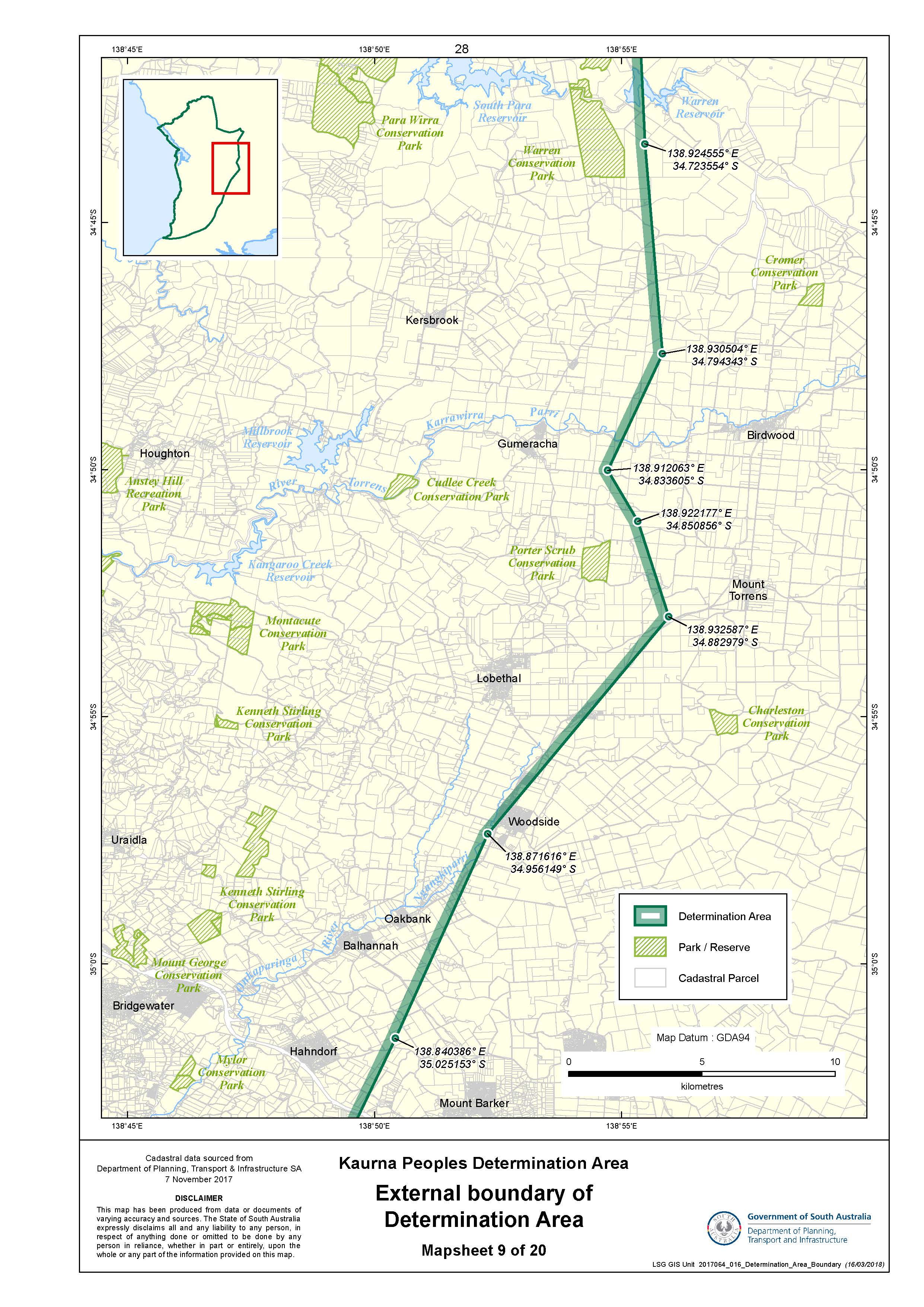
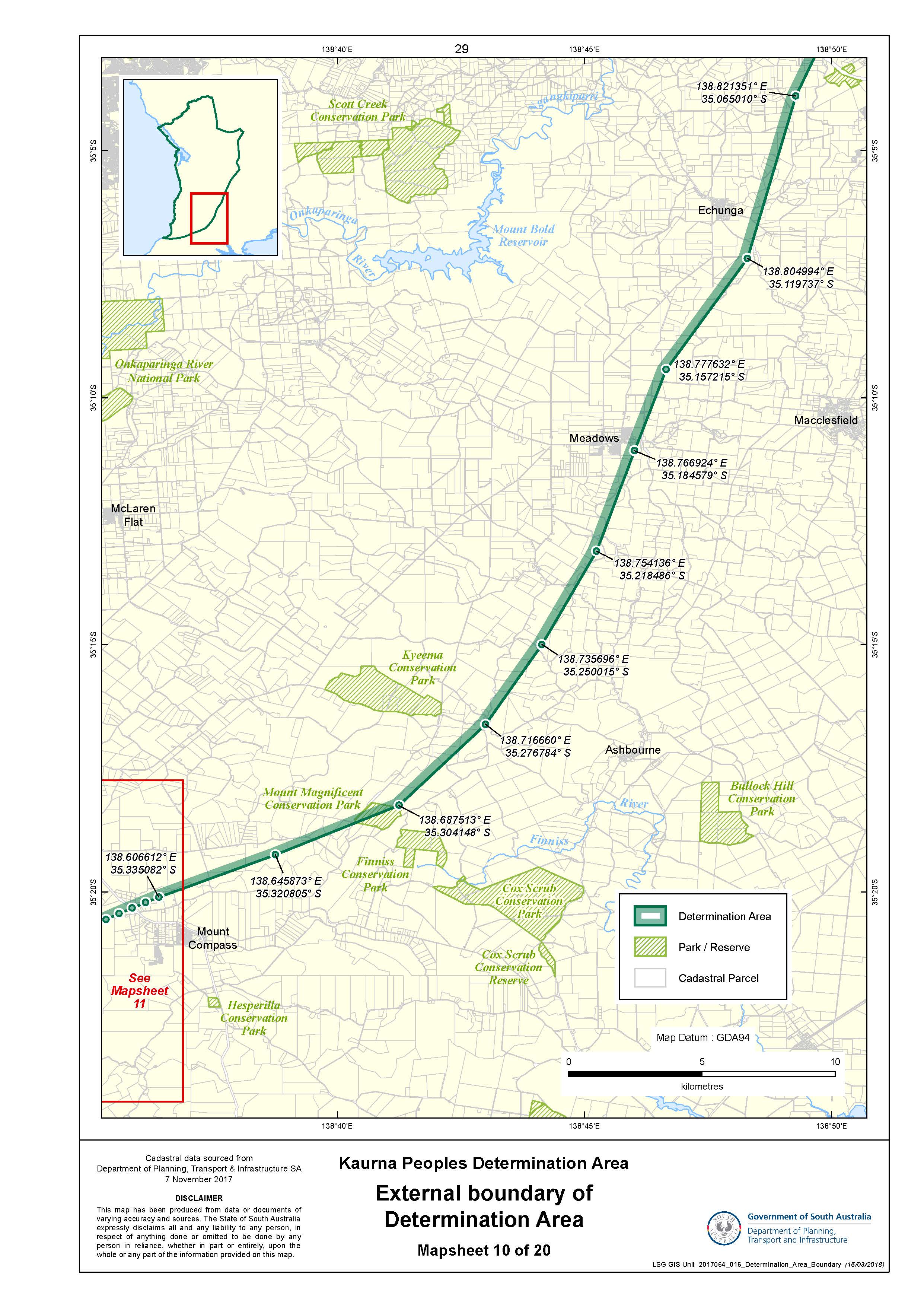
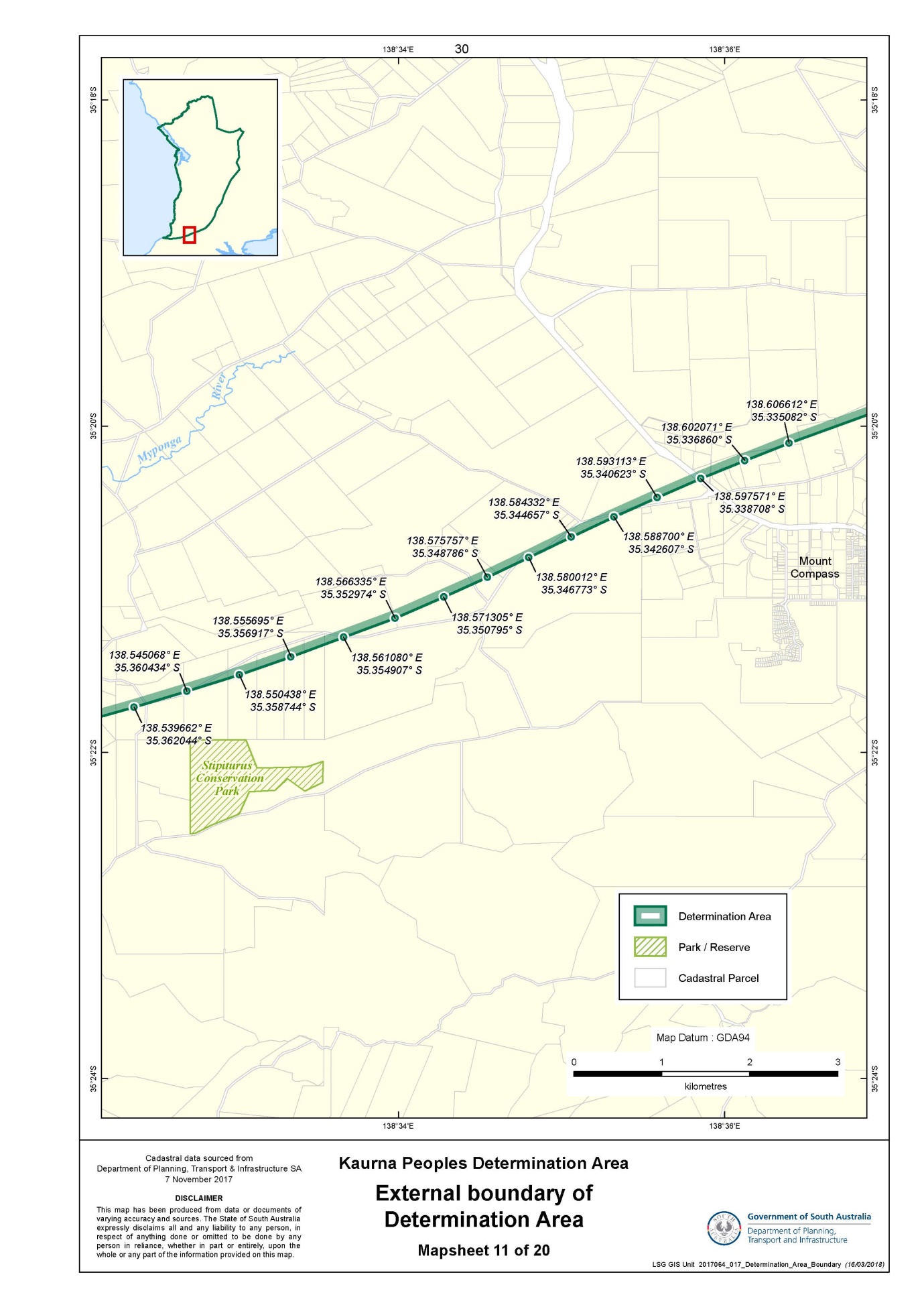
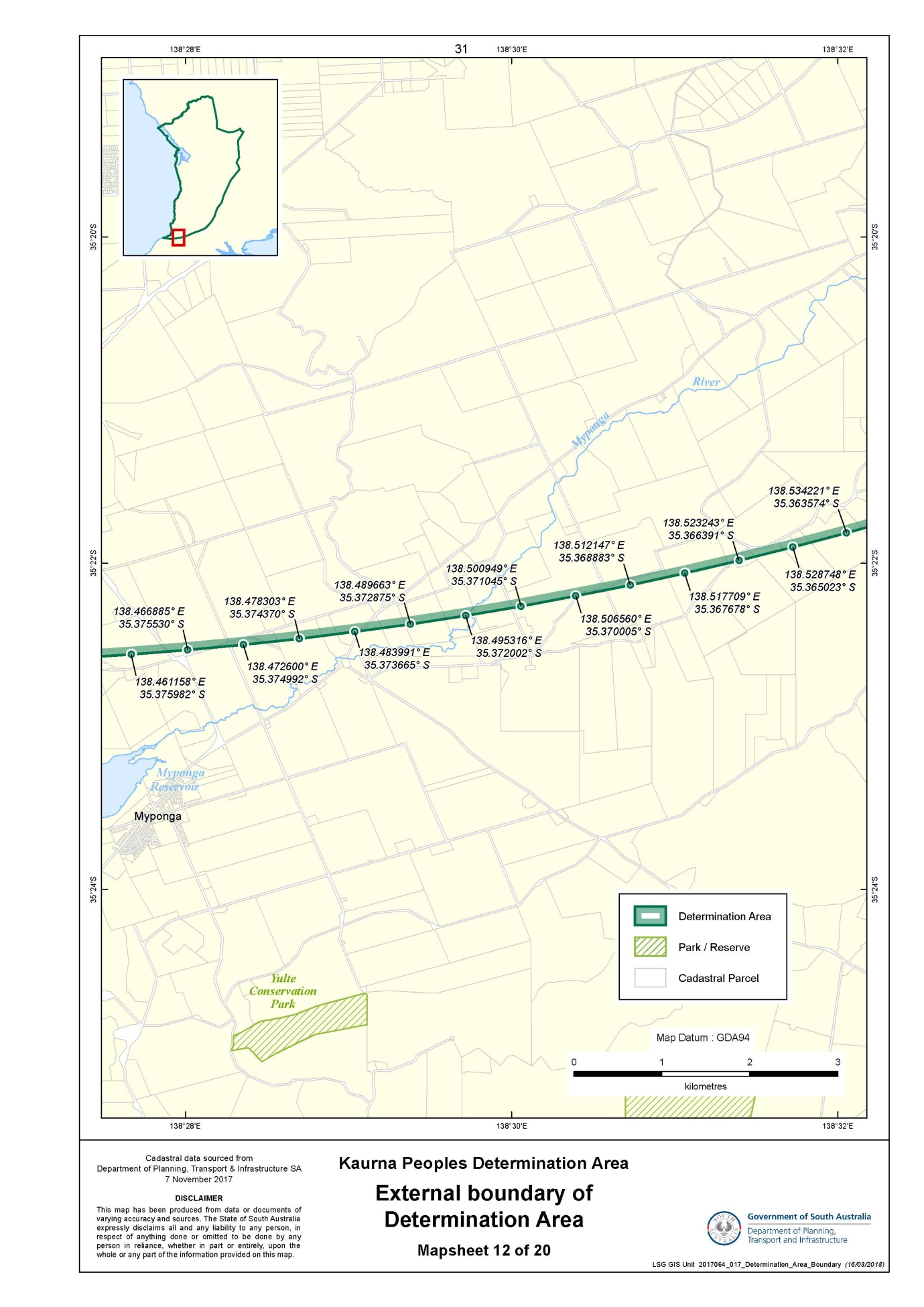
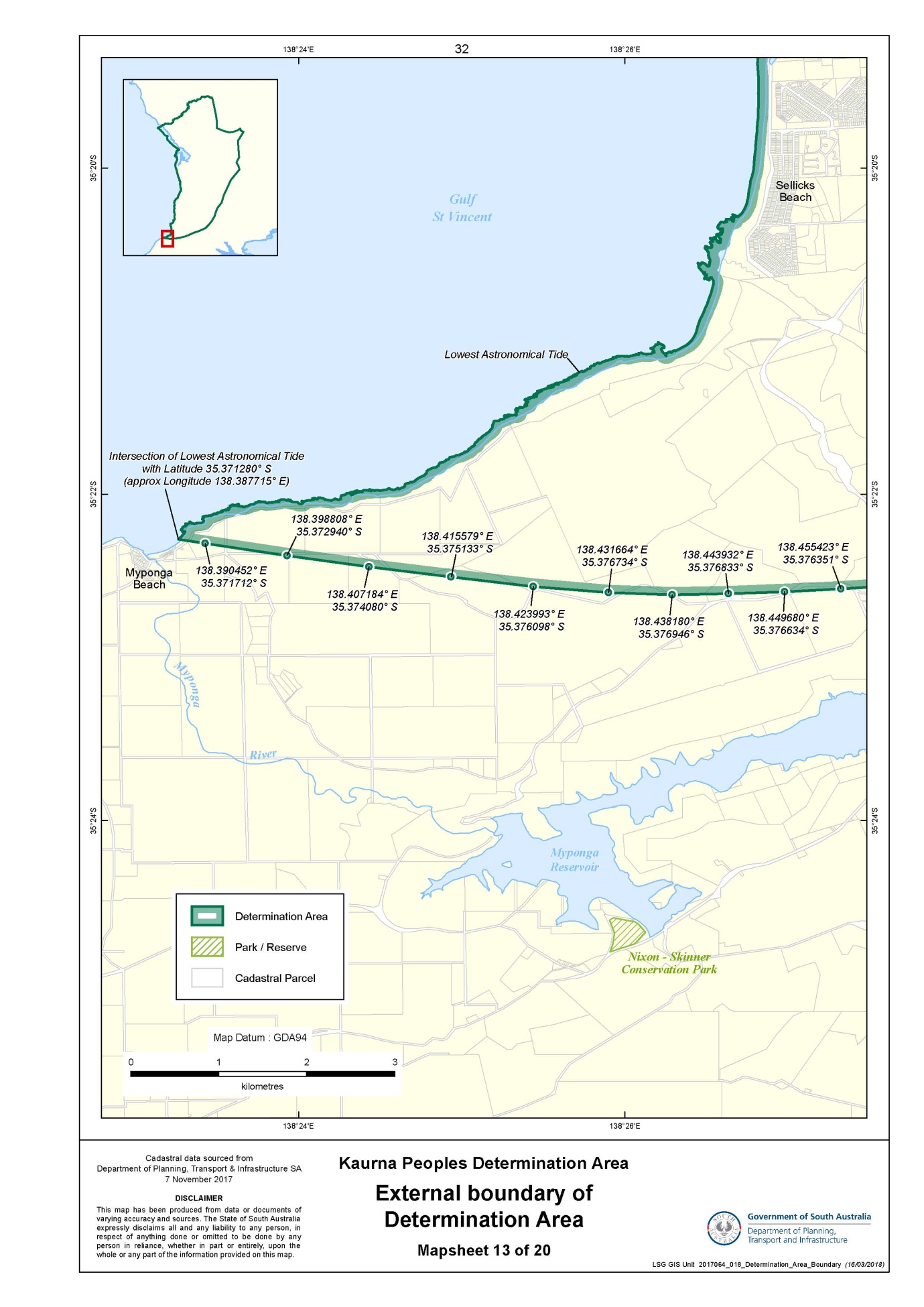
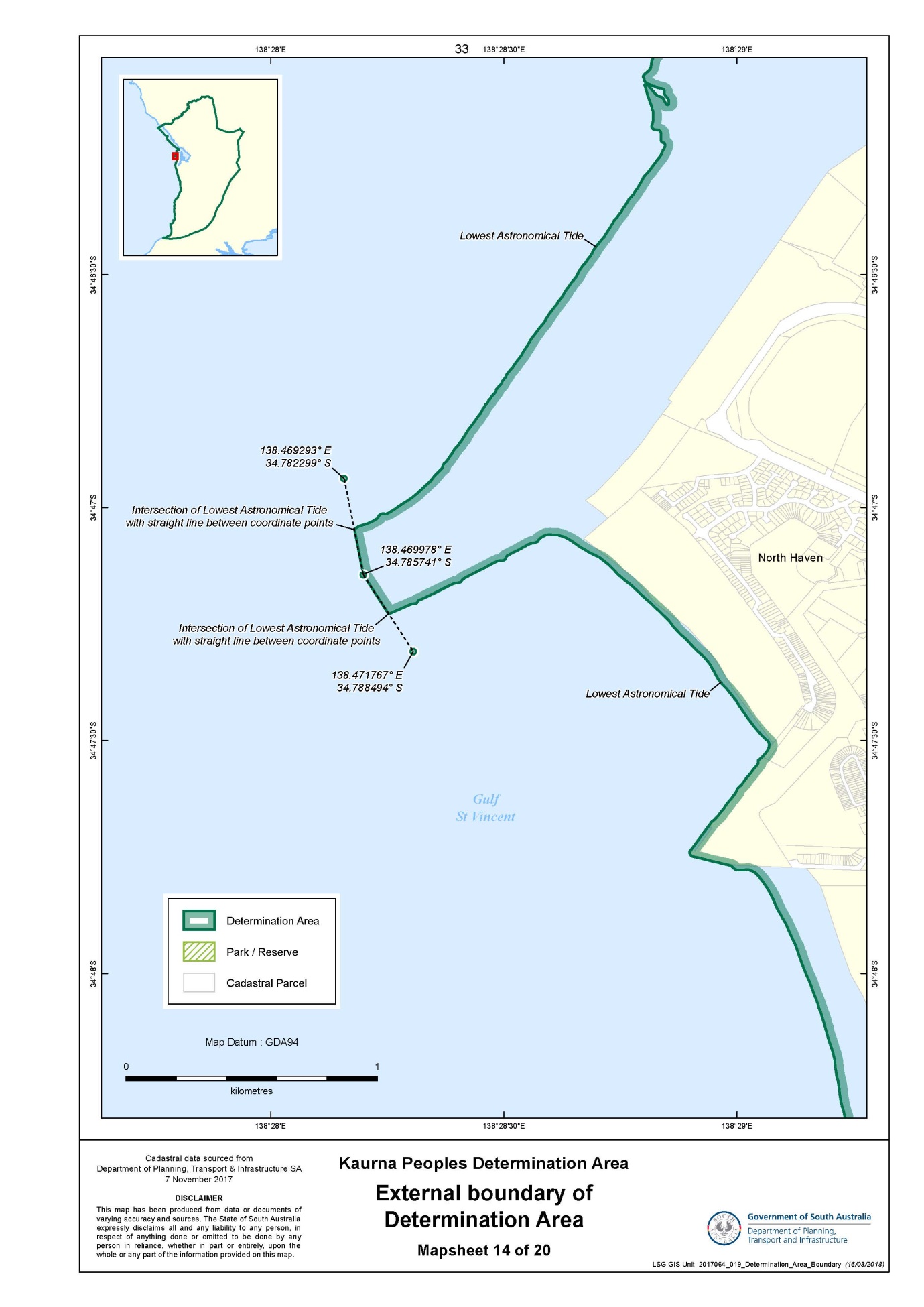
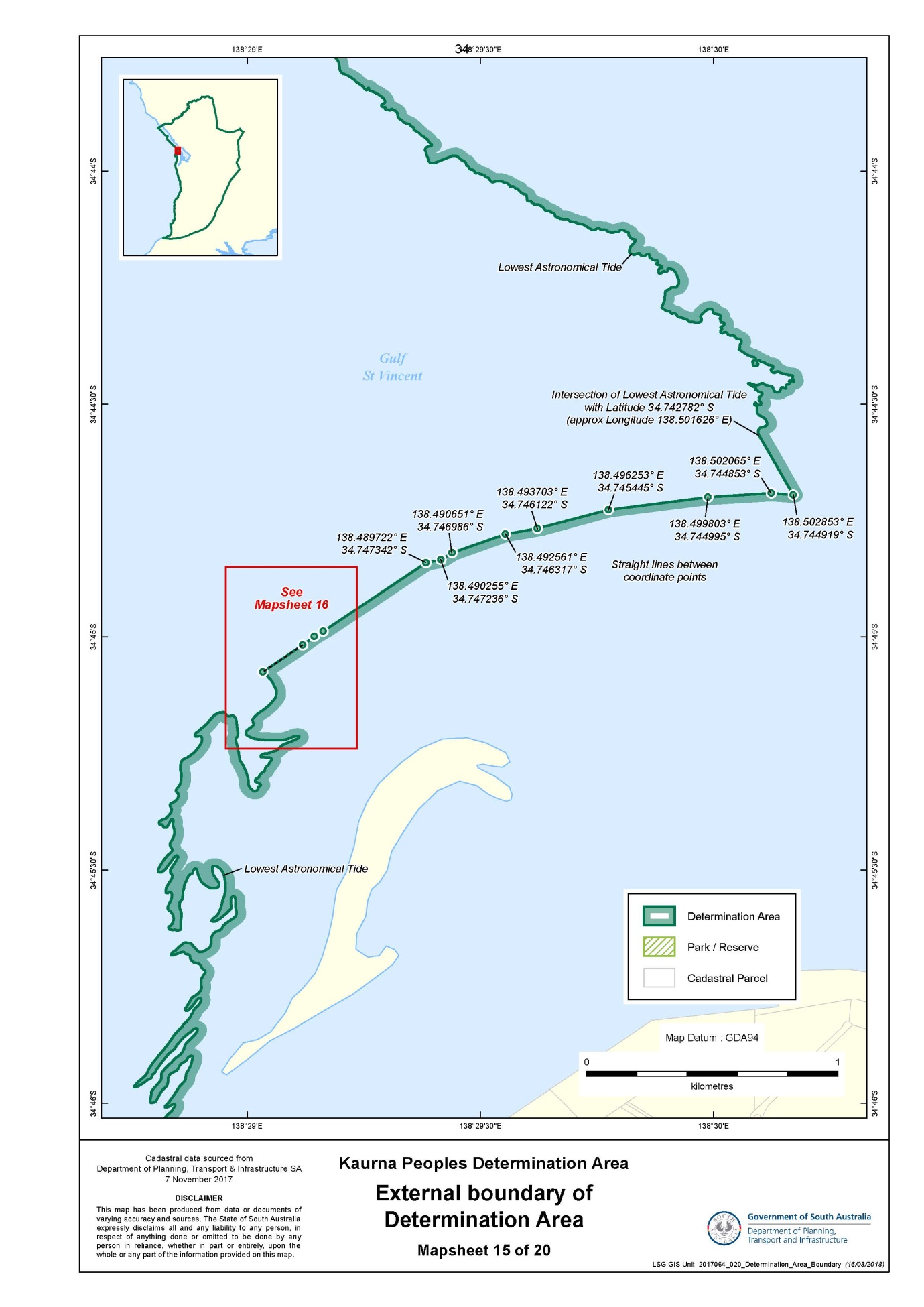
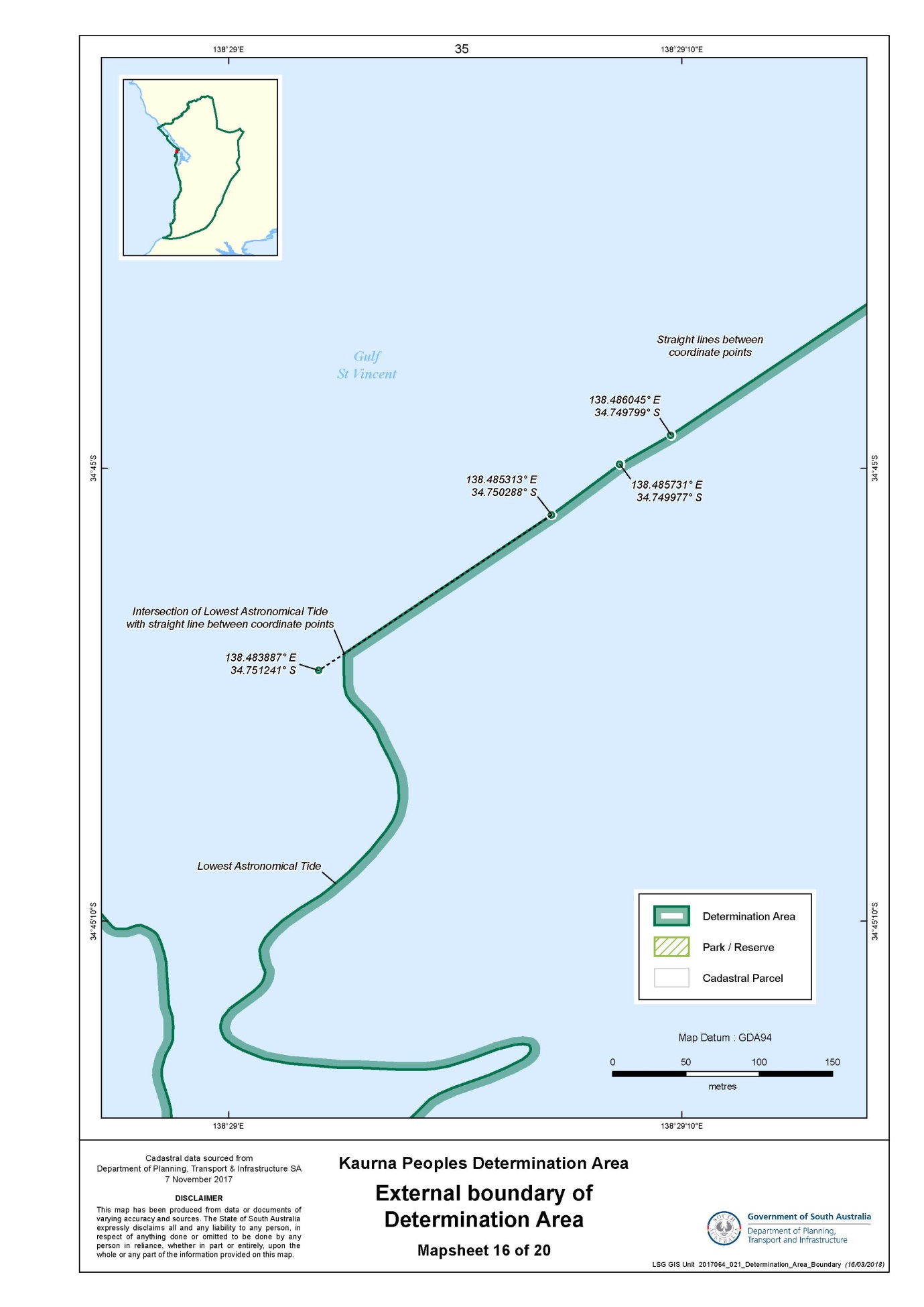
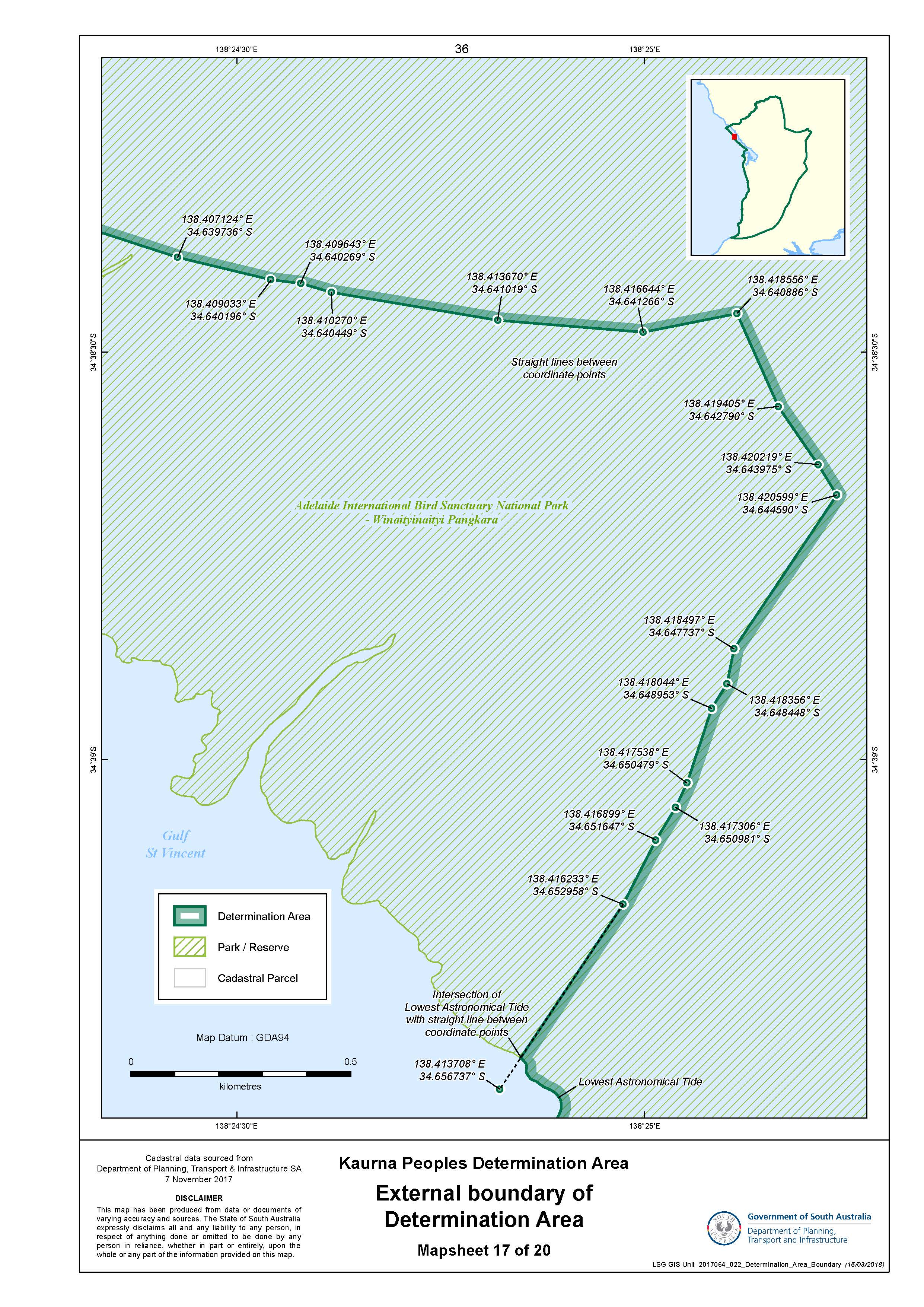
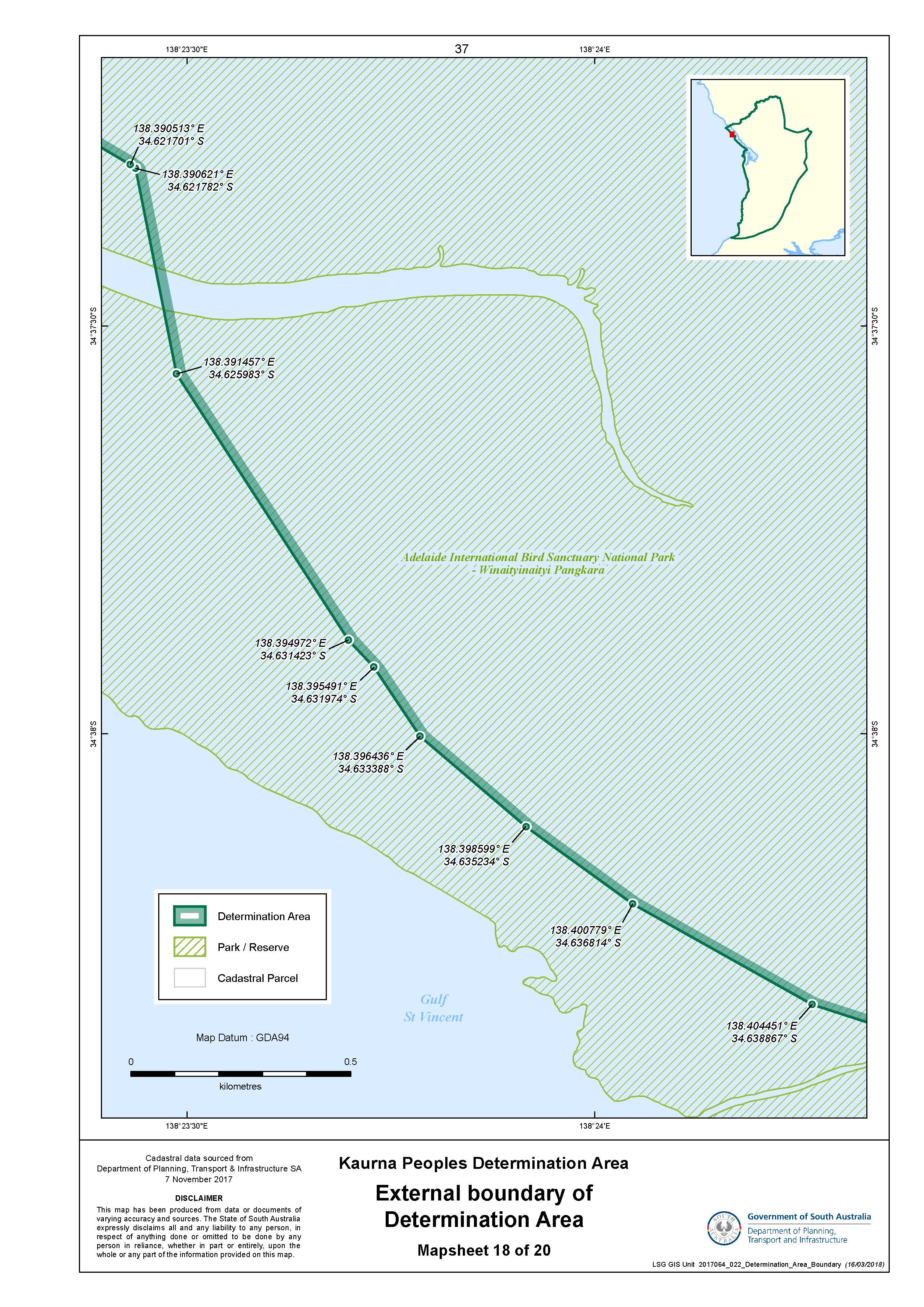
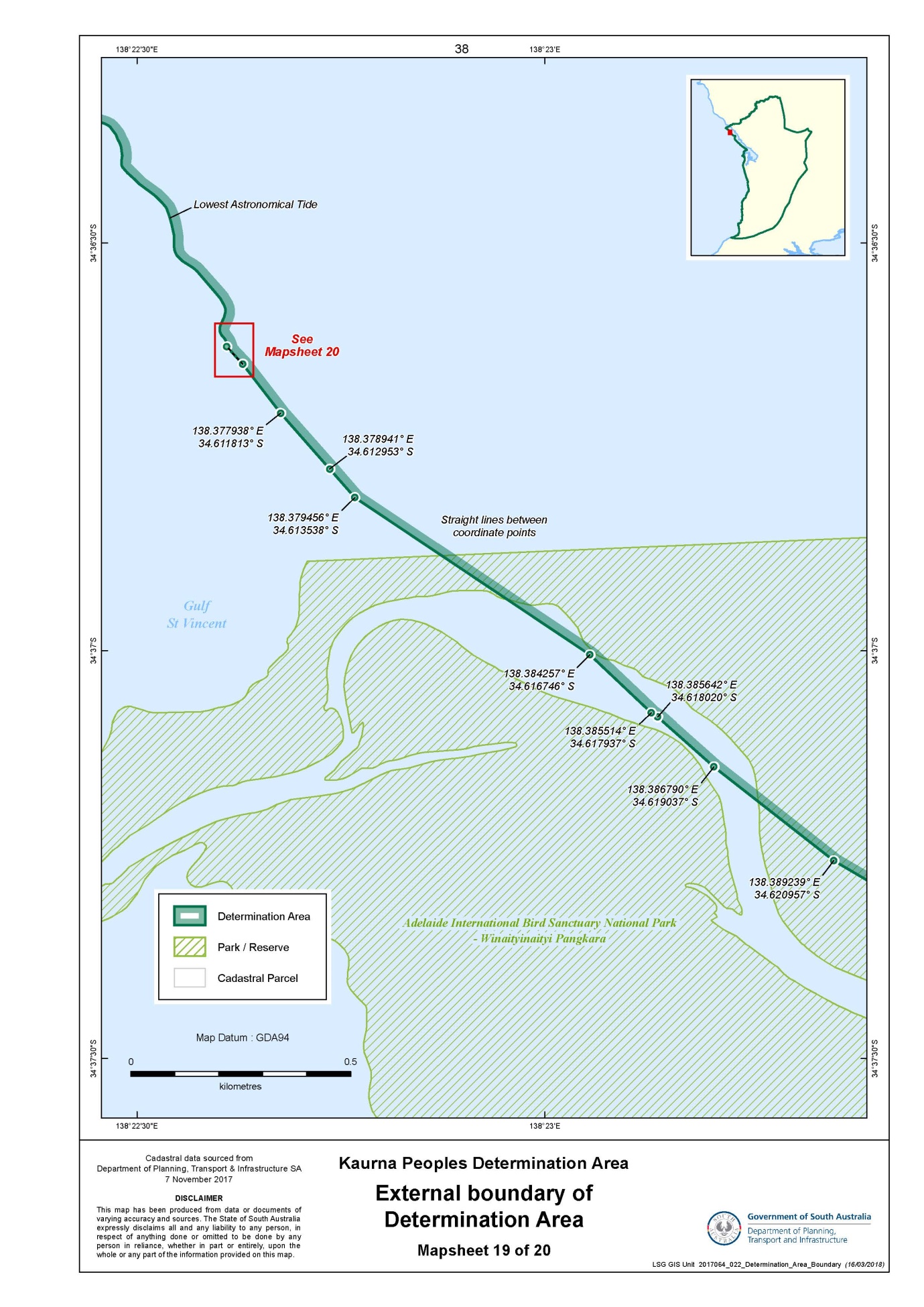
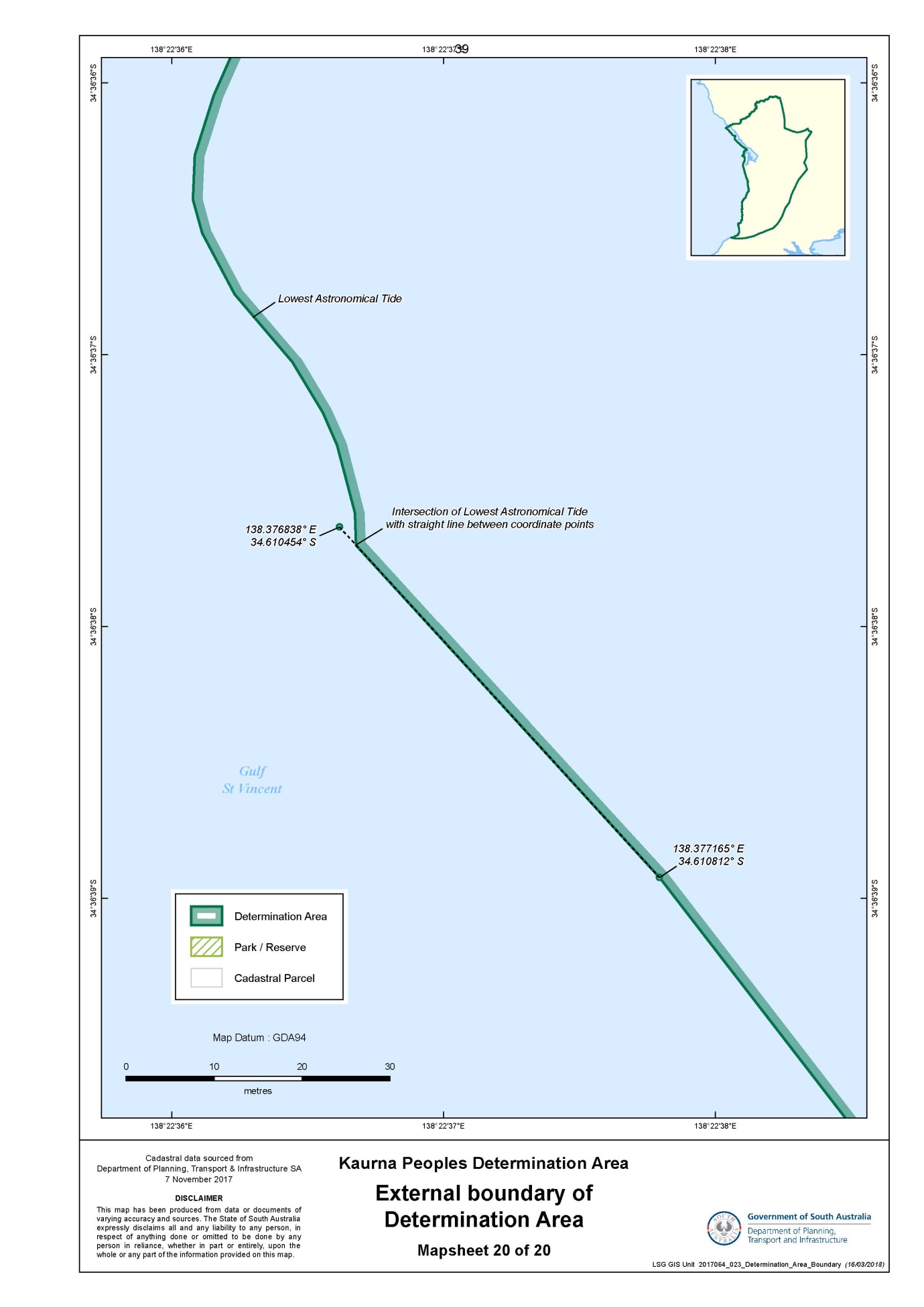
SCHEDULE 2 - Maps
Part B: Maps depicting Native Title Land
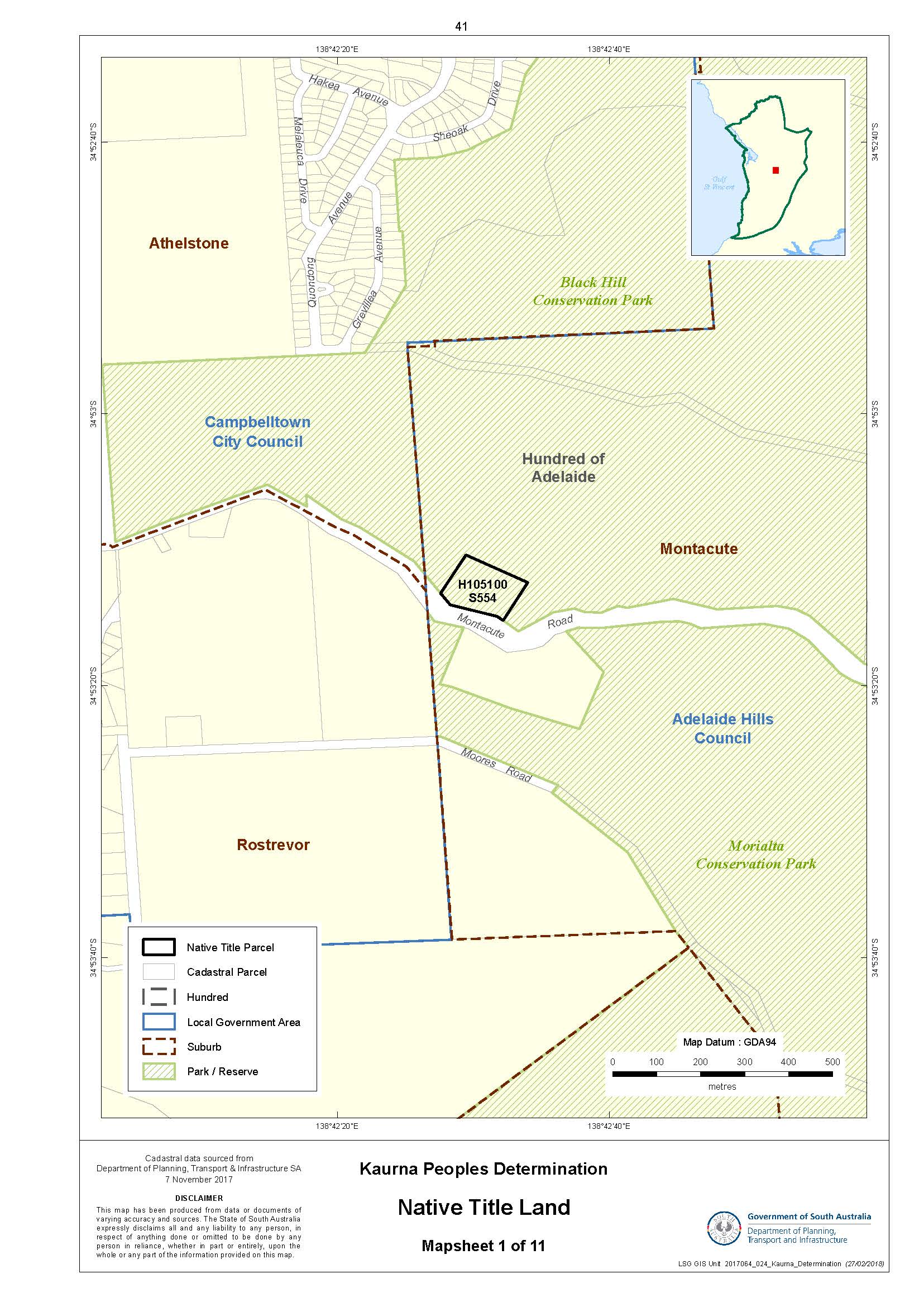
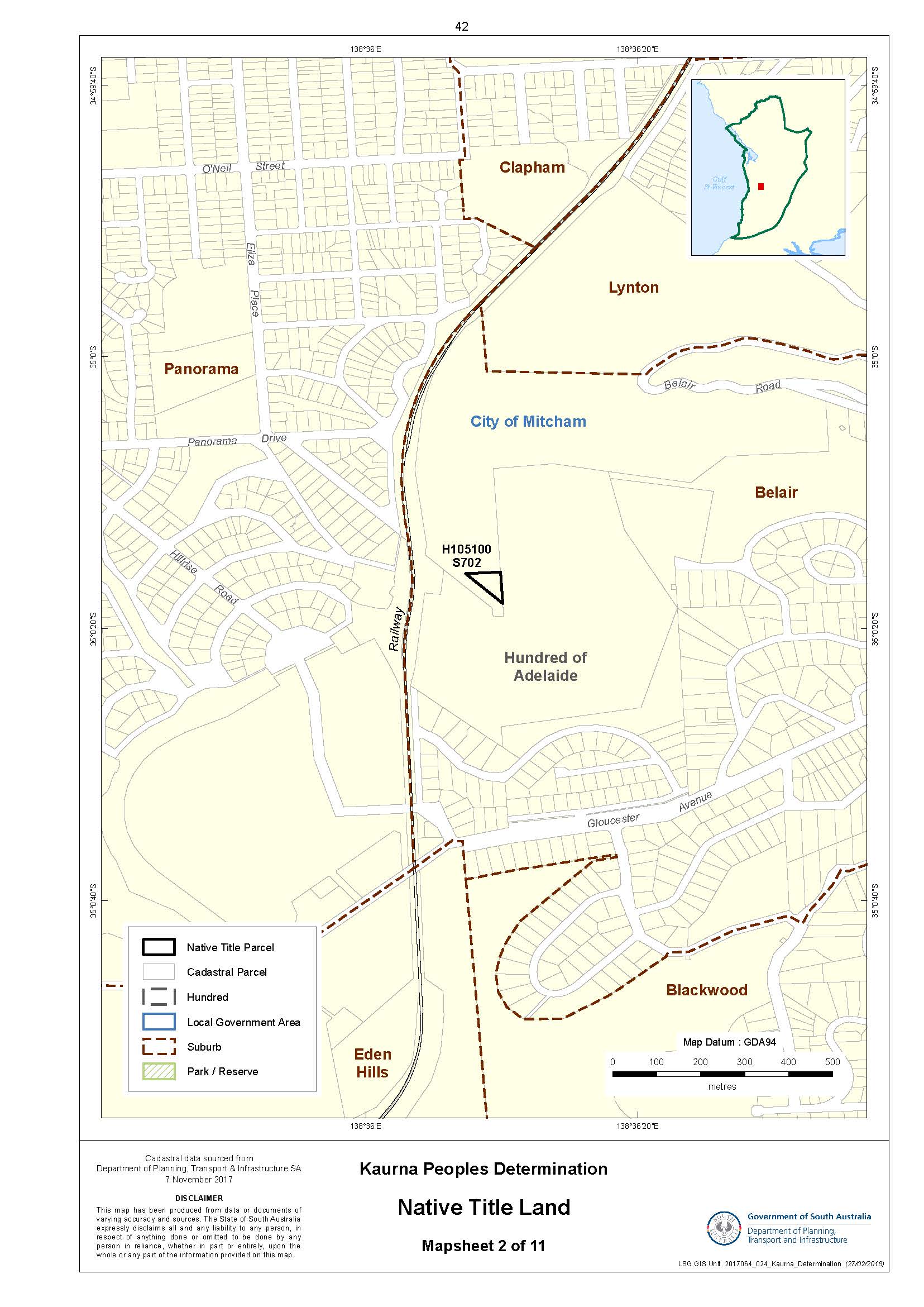
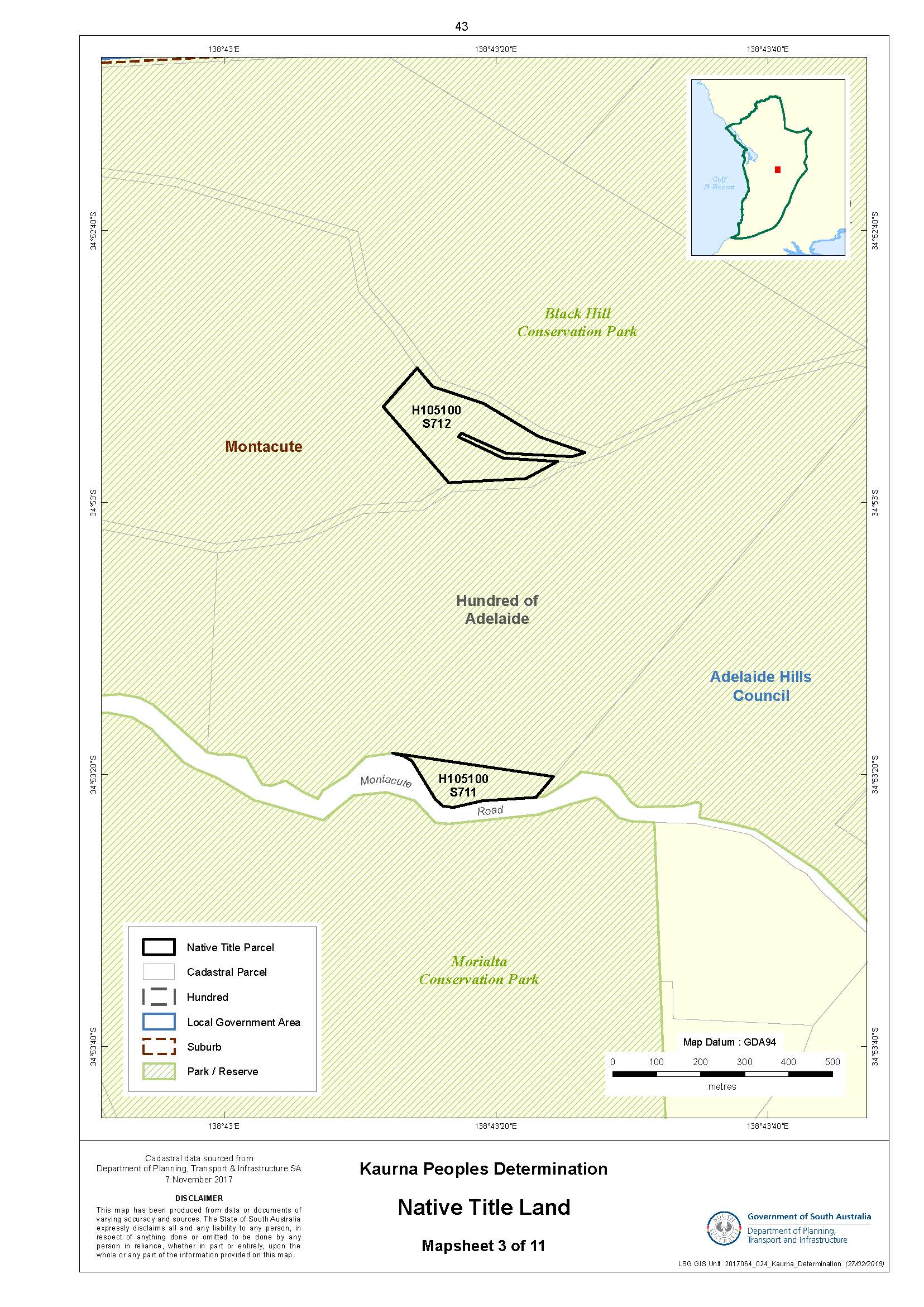
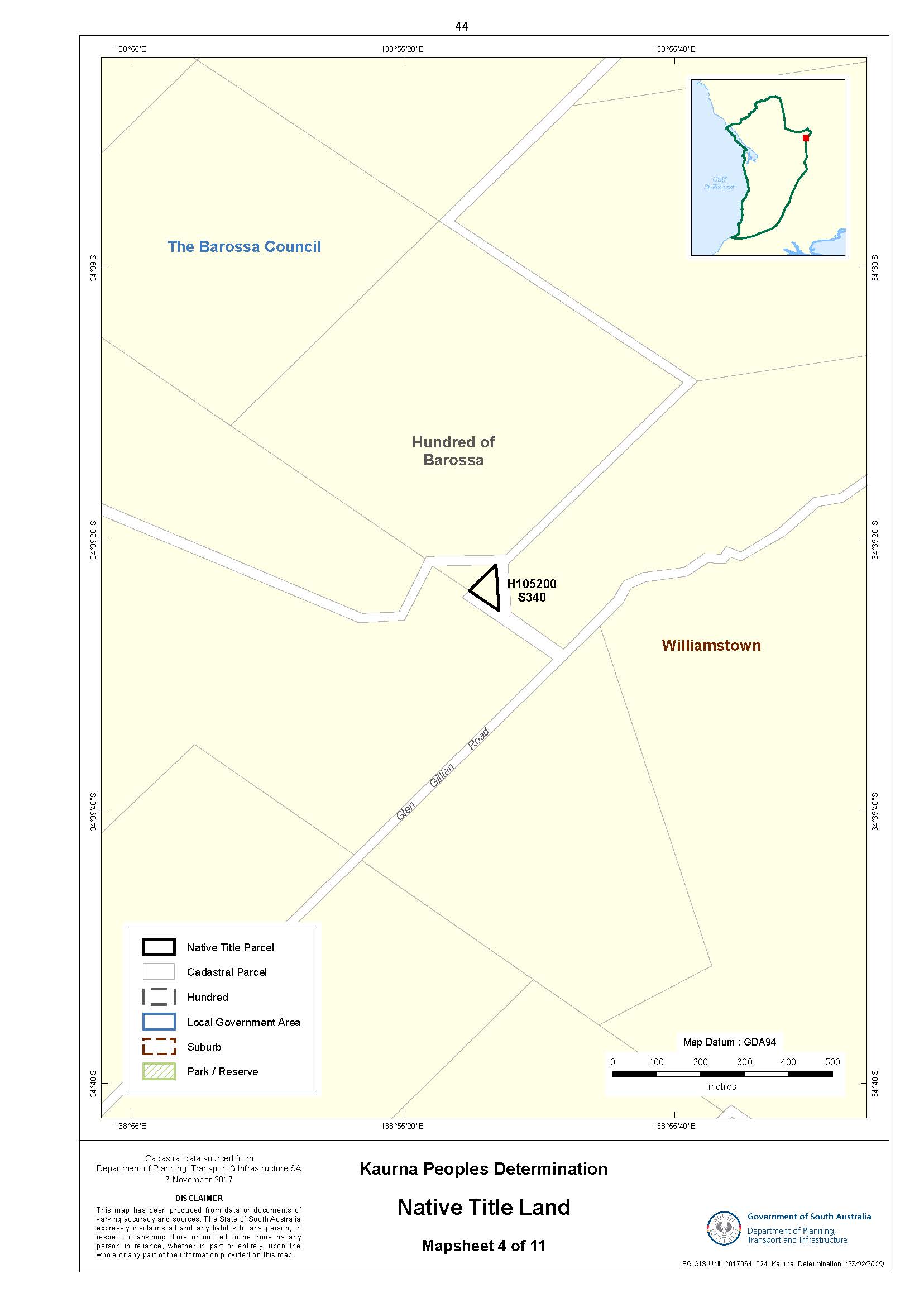
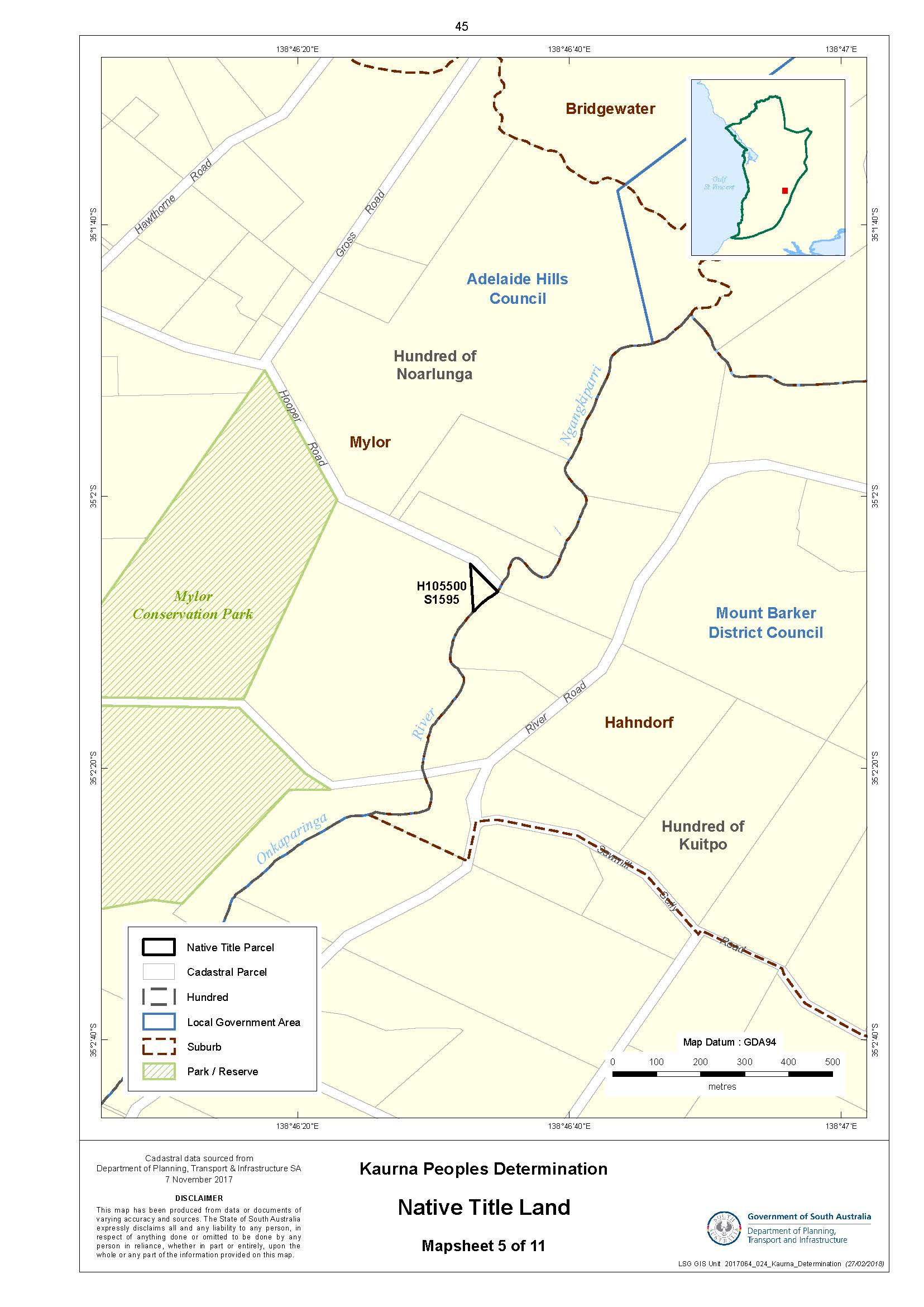
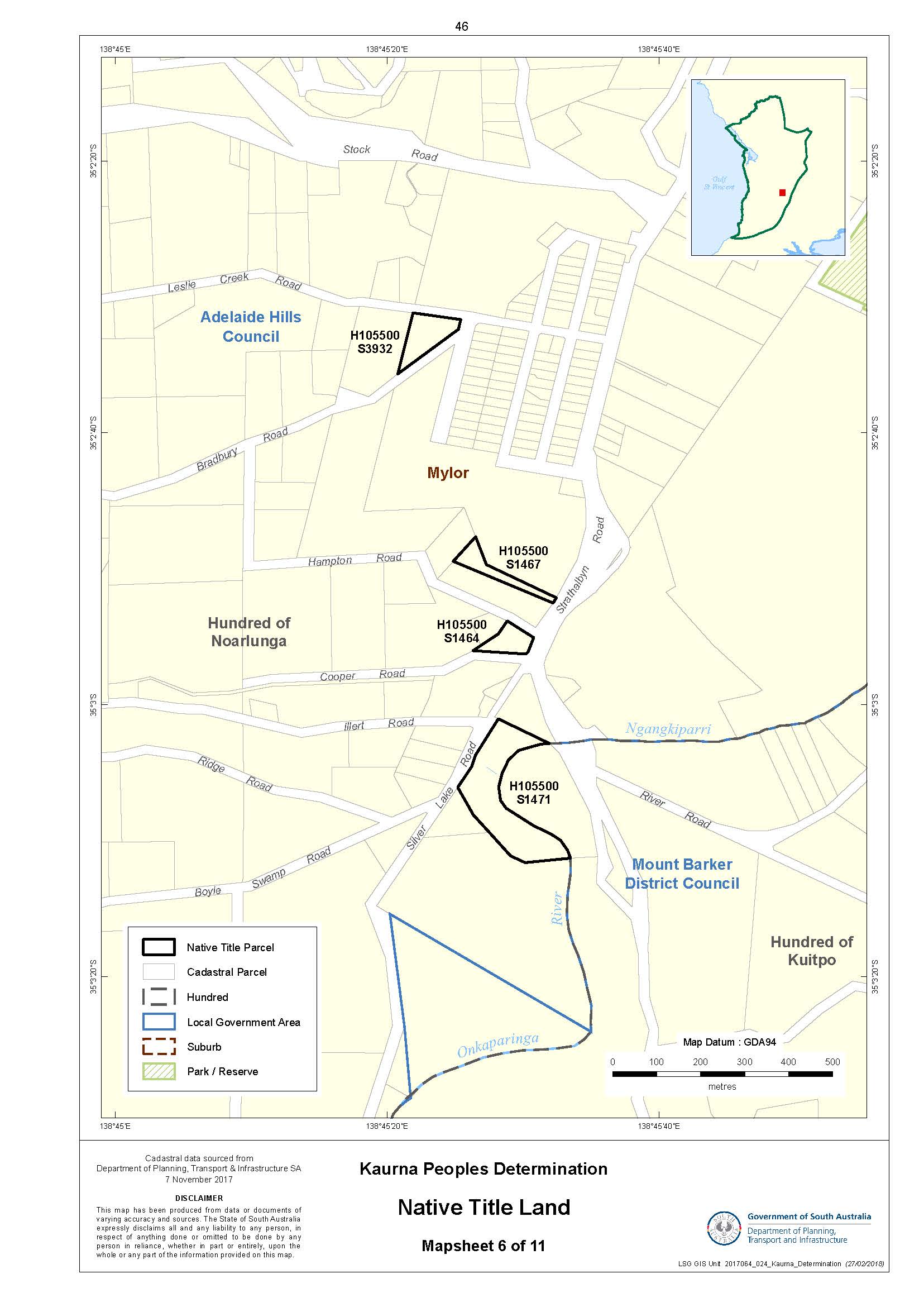
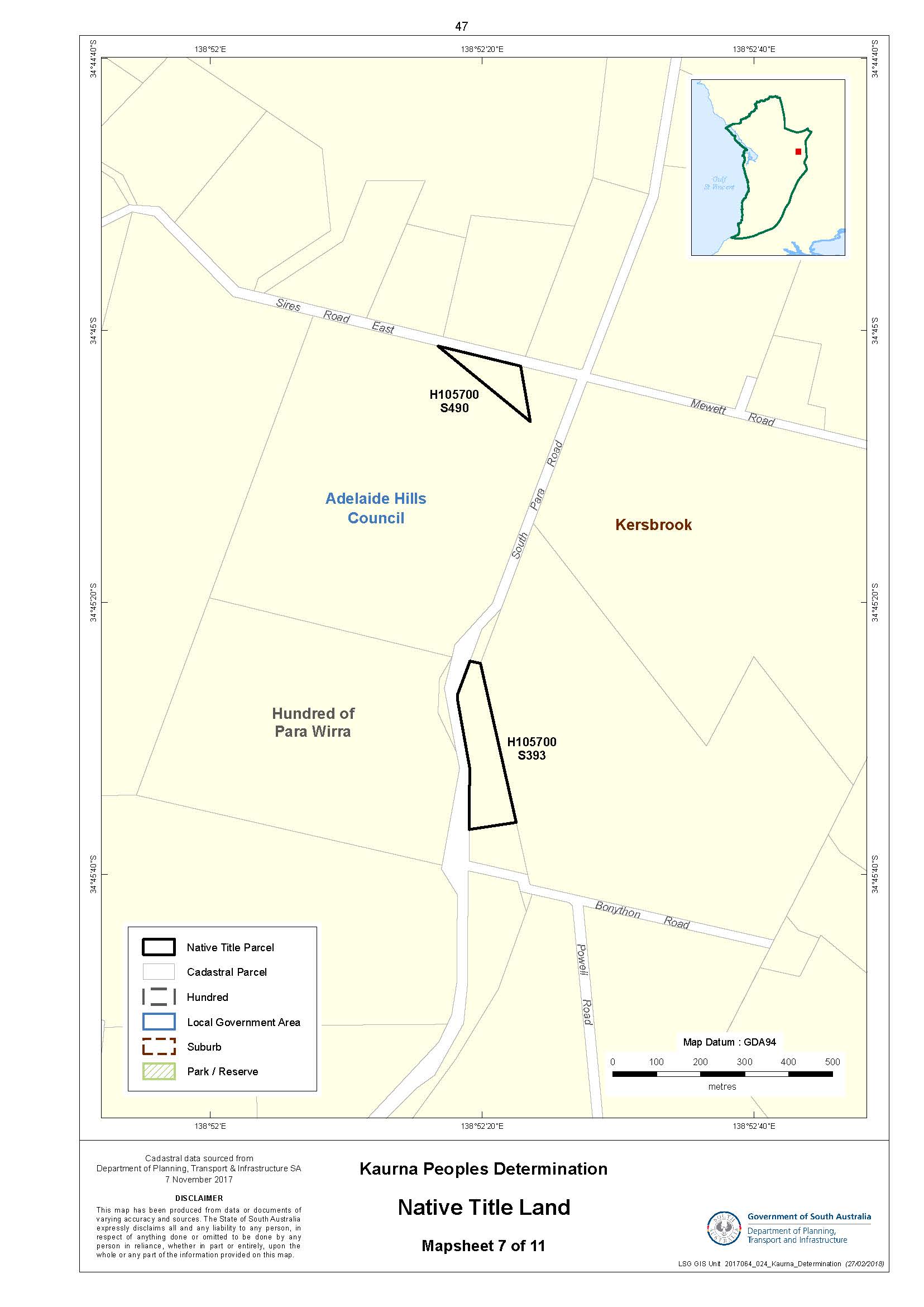
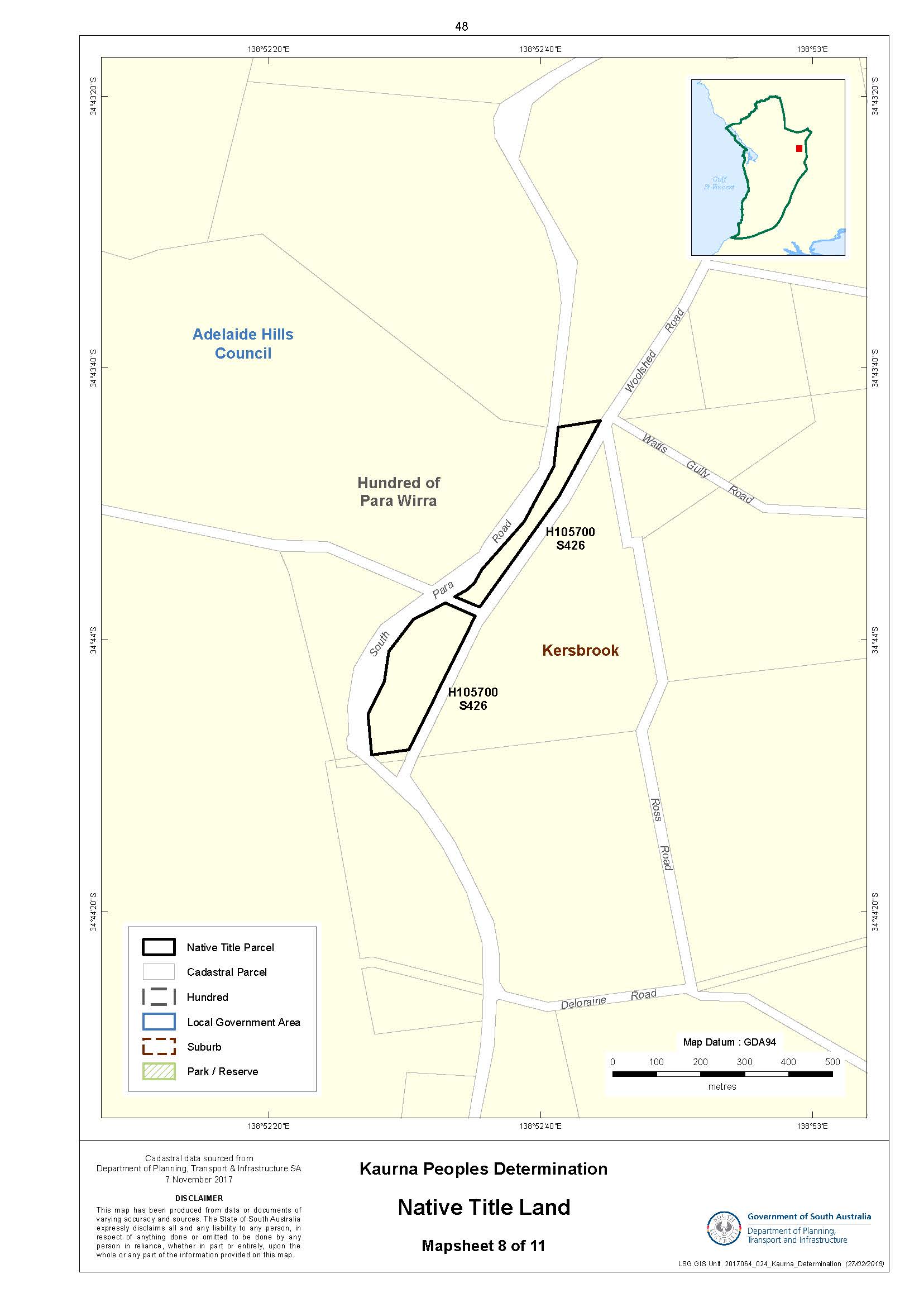
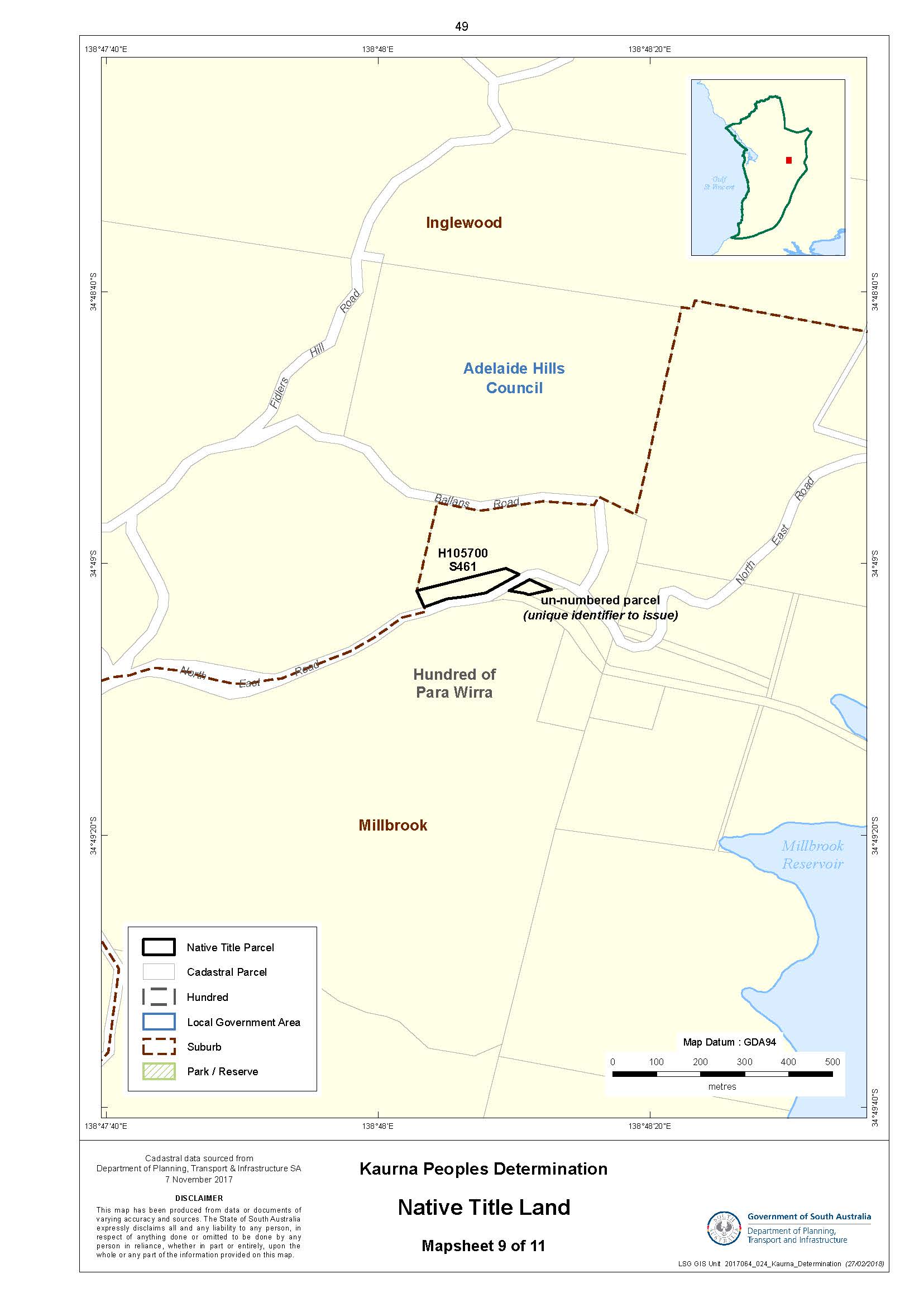
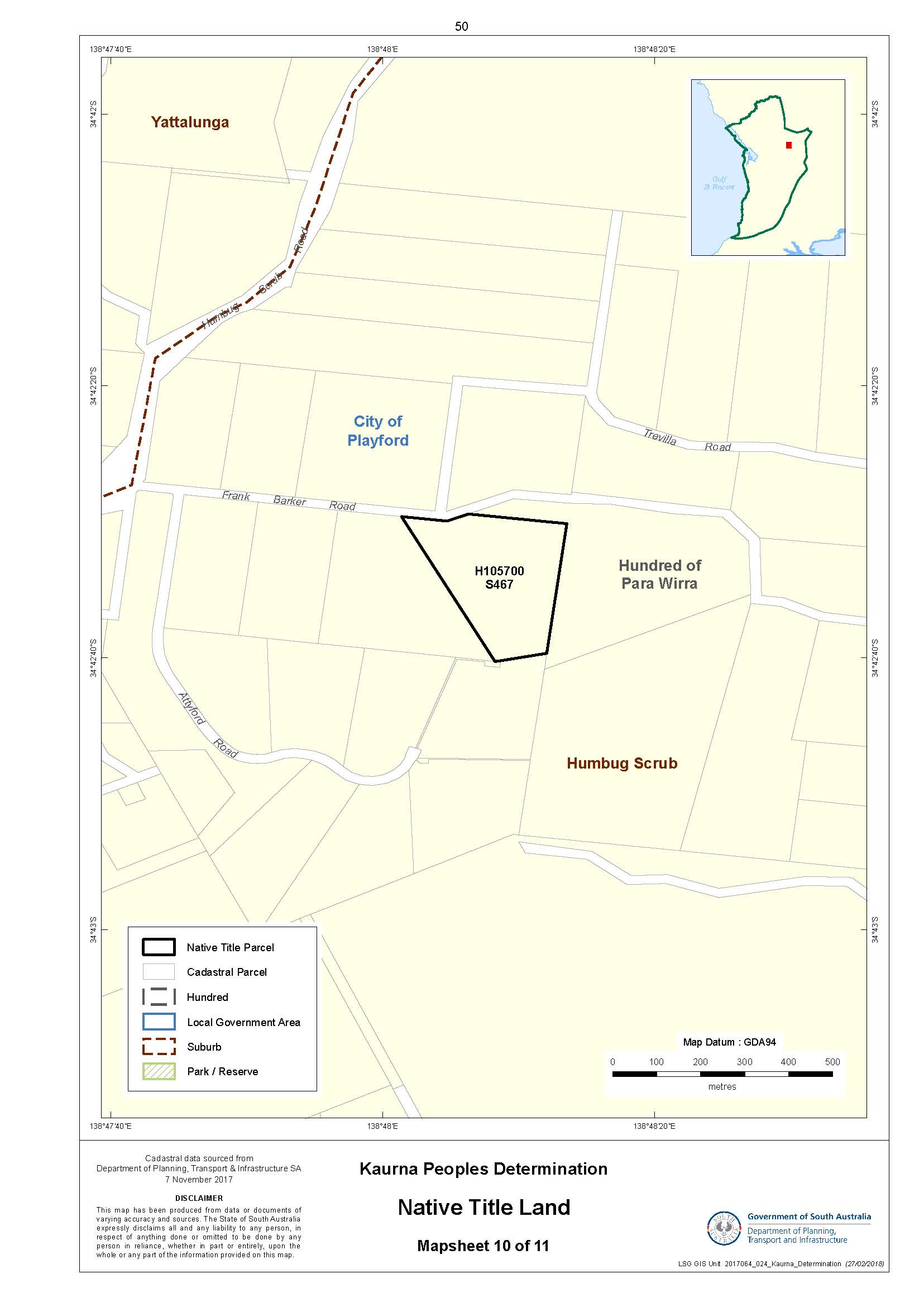
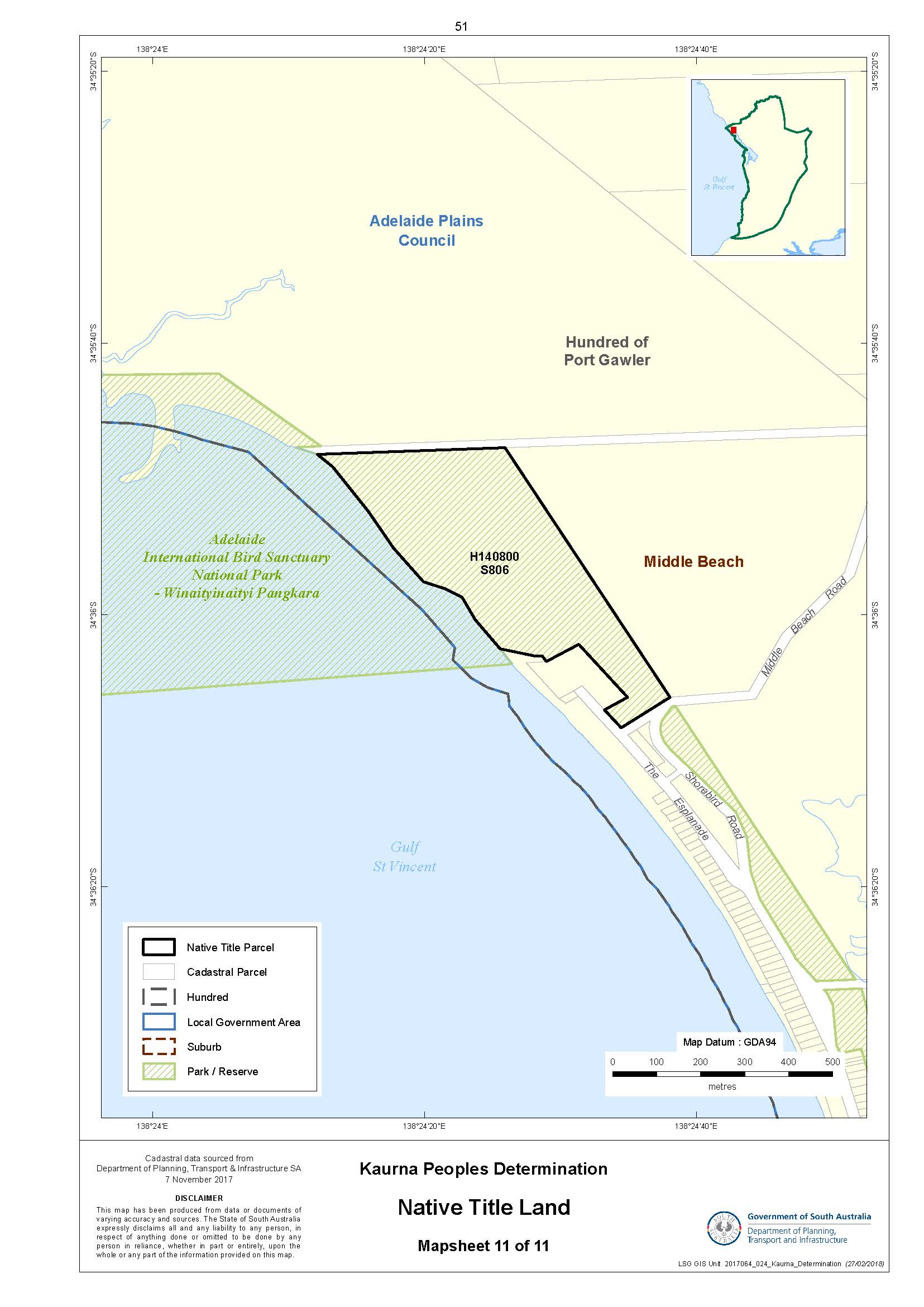
SCHEDULE 3 – Land and waters where native title exists (Native Title Land)
Note: Please refer to Schedule 2 Part B for further detail where a portion of a parcel is indicated.
Parcel Identifier | Hundred | General Area | Other interests (Council with care, control & management)) |
H105100S554 | Adelaide | Black Hill Conservation Park | Conservation Park |
H105100S702 | Adelaide | Portion of Sleeps Hill Quarry site | Public Bike Trail, Waterworks easement over southern portion. (City of Mitcham) |
H105100S711 | Adelaide | Black Hill Conservation Park | Conservation Park |
H105100S712 | Adelaide | Black Hill Conservation Park | Conservation Park, Black Hill Track, Trig Point |
H105200S340 | Barossa | Williamstown | Reserve, Gas Pipeline on south west boundary |
H105500S1464 | Noarlunga | Mylor | Parklands, Hampton Rd (Adelaide Hills Council) |
H105500S1467 | Noarlunga | Mylor | Parklands (Adelaide Hills Council) |
H105500S1471 | Noarlunga | Mylor | Water Reserve, Vogt Road (Adelaide Hills Council) |
H105500S1595 | Noarlunga | Mylor | Water Reserve (Adelaide Hills Council) |
H105500S3932 | Noarlunga | Mylor | Parklands, [Not sporting grounds, etc that are on the same Crown Record] (Adelaide Hills Council) |
H105700S393 | Para Wirra | Kersbrook | Recreation Reserve, Parking Bay on South Para Road (Adelaide Hills Council) |
H105700S426 | Para Wirra | Kersbrook | Roadway at northern end. Conservation Heritage Agreement under s23 Native Vegetation Act 1991 in progress (Adelaide Hills Council) |
H105700S461 | Para Wirra | Millbrook | Water Reserve, Bush For Life site with ongoing land management activities such as weed control, access tracks, fencing |
H105700 Unique identifier to issue - See Mapsheet 9 of 11 | Para Wirra | Millbrook | Water Reserve, Bush For Life site with ongoing land management activities such as weed control, access tracks, fencing |
H105700S467 | Para Wirra | Humbug Scrub | Water Reserve, Vehicle track on western side, Annual Licence 17134 to SA Power Network for Powerlines |
H105700S490 | Para Wirra | Kersbrook | Water Reserve, Powerline Easement to Electranet Pty Ltd (Adelaide Hills Council) |
H140800S806 | Port Gawler | Middle Beach | Adelaide International Bird Sanctuary National Park, Any encroachment by adjacent Caravan Park, Annual Licence 22105 for pump, pipeline and walking trail |
SCHEDULE 4 - Areas where native title do not exist
1. Native title rights and interests do not exist in:
(a) minerals as defined in section 6 of the Mining Act 1971 (SA);
(b) petroleum, as defined in section 4 of the Petroleum and Geothermal Energy Act 2000 (SA);
(c) a naturally occurring underground accumulation of a regulated substance as defined in section 4 of the Petroleum and Geothermal Energy Act 2000 (SA), below a depth of 100 metres from the surface of the earth;
(d) a natural reservoir, as defined in section 4 of the Petroleum and Geothermal Energy Act 2000 (SA), below a depth of 100 metres from the surface of the earth;
(e) geothermal energy, as defined in section 4 of the Petroleum and Geothermal Energy Act 2000 (SA) the source of which is below a depth of 100 metres from the surface of the earth.
For the purposes of this item 1 and the avoidance of doubt:
(f) a geological structure (in whole or in part) on or at the earth’s surface or a natural cavity which can be accessed or entered by a person through a natural opening in the earths surface, is not a natural reservoir;
(g) thermal energy contained in a hot or natural spring is not geothermal energy as defined in section 4 of the Petroleum and Geothermal Energy Act 2000 (SA);
(h) the absence from this Order of any reference to a natural reservoir or a naturally occurring accumulation of a regulated substance, as those terms are defined in section 4 of the Petroleum and Geothermal Energy Act 2000 (SA), above a depth 100 metres below the surface of the earth or geothermal energy the source of which is above a depth of 100 metres below the surface of the earth is not, of itself, to be taken as an indication of the existence or otherwise of native title rights or interests in such natural reservoir, naturally occurring accumulation of a regulated substance or geothermal energy.
2. Native title rights and interests have been extinguished in the areas of Native Title Land covered by Public Works (including the land and waters defined in section 251D of the NTA) which were constructed, established or situated prior to 23 December 1996 or commenced to be constructed or established on or before that date.
3. Public Works constructed, established or situated after 23 December 1996 on Native Title Land have had such effect as has resulted from Part 2, Division 3, of the NTA.
4. Native title rights and interests have been extinguished over all roads which have been delineated in a public map pursuant to section 5(d)(ii) of the Crown Lands Act 1929 (SA) or section 70(3) or (4) of the Crown Land Management Act 2009 (SA) or which have otherwise been validly established pursuant to South Australian statute or common law.
5. Native title rights and interests do not exist over any land and waters within the Determination Area other than those parcels listed at Schedule 3.
SCHEDULE 5- Details of Indigenous Land Use Agreements in the Determination Area
Kaurna Peoples Native Title Settlement ILUA
SCHEDULE 6 – Existing interests of SA Power Networks
CONDUCTORS
Asset Type | Operating Voltage | Parcel ID | Title Ref | Hundred Name |
Overhead Low Voltage Conductor | 433V | H105500S1471 | CR5753/712 | NOARLUNGA |
Overhead Low Voltage Conductor | 433V | H105500S3932 | CR6143/903 | NOARLUNGA |
Overhead Low Voltage Conductor | 433V | H105700S467 | CR5744/248 | PARA WIRRA |
Overhead High Voltage Conductor | 11KV | H105700S467 | CR5744/248 | PARA WIRRA |
TRANSFORMERS
Parcel ID | Title Ref | Hundred Name | TF Type | Asset Type | Input Voltage | Output Voltage |
H105700S467 | CR5744/248 | PARA WIRRA | Pole Mounted | Pole Mounted Transformer | 11KV | 433V |
SCHEDULE 7
No: (P)SAD6001/2000
Federal Court of Australia
District Registry: South Australia
Division: General
NATIVE TITLE ACTION FILED BY KAURNA NATIVE TITLE CLAIM
Applicant: LYNETTE CROCKER
Applicant: MAUREEN WANGANEEN
Applicant: GLENICE SUMNER
Applicant: JOSEPH MITCHELL
Applicant: GEORGINA WILLIAMS
Applicant: DENNIS DAVIES
Applicant: SUZANNE RUSSELL
Applicant: RODNEY O'BRIEN
Applicant: FRANK WANGANEEN
Applicant: CECIL GRAHAM
Applicant: VINCE BUCKSKIN
Respondent: CITY OF CHARLES STURT
Respondent: CAMPBELLTOWN CITY COUNCIL
Respondent: BAROSSA COUNCIL
Respondent: ALEXANDRINA COUNCIL
Respondent: ADELAIDE PLAINS COUNCIL
Respondent: CITY OF PLAYFORD
Respondent: CITY OF MARION
Respondent: CITY OF HOLDFAST BAY
Respondent: CITY OF PORT ADELAIDE ENFIELD
Respondent: CITY OF ONKAPARINGA
Respondent: CITY OF MITCHAM
Respondent: ADELAIDE CITY COUNCIL
Respondent: DISTRICT COUNCIL OF YANKALILLA
Respondent: COUNCIL OF THE CITY OF PROSPECT
Respondent: CORPORATION OF THE CITY OF NORWOOD, PAYNEHAM & ST PETERS
Respondent: CITY OF WEST TORRENS
Respondent: CITY OF TEA TREE GULLY
Respondent: CITY OF SALISBURY
Respondent: LIGHT REGIONAL COUNCIL
Respondent: CORPORATION OF THE CITY OF UNLEY
Respondent: AMBRO PTY LTD
Respondent: GINA BATTISTELLA
Respondent: GIANNI BATTISTELLA
Respondent: UNIVERSITY OF ADELAIDE, VICE-CHANCELLOR
Respondent: FRANK WOLFGANG BARONS
Respondent: FRANCES MARGARET BARONS
Respondent: PAULINE ANN BARKER
Respondent: MAUREEN MARGARET BARKER
Respondent: DAVID JOHN BARKER
Respondent: BRIAN CHARLES BARKER
Respondent: ROGER JOHN APPLEBEE
Respondent: LORRAINE FLORENCE APPLEBEE
Respondent: ANGELO NOMINEES PTY LTD
Respondent: A & V BERGAMIN PTY LTD
Respondent: A.S.C. LTD
Respondent: JON CAMERON-HILL
Respondent: MARIA CARPINELLI
Respondent: BETHANY CHRISTIAN SCHOOL
Respondent: BFG INVESTMENTS PTY LTD ACN 067 925 562
Respondent: DENNIS BOTTIN
Respondent: PAUL BOTTIN
Respondent: FRANK CALVARESI
Respondent: BRUNO CALVARESI
Respondent: C & I CIROCCO NOMINEES PTY LTD
Respondent: VENNETTA MILLIE BRUS
Respondent: RUBY EDITH BRUS
Respondent: ALLEN ALFRED BRUS
Respondent: MALVINA BRAZZALOTTO
Respondent: FRANCO BRAZZALOTTO
Respondent: LINA BRAZZALOTTO
Respondent: BOWTHORPE PTY LTD
Respondent: FRANCESCO CARBONE
Respondent: ZOFIA BOTTIN
Respondent: SUSAN LEE BOTTIN
Respondent: ROBERT BOTTIN
Respondent: HORST BEIER
Respondent: CARMELA CARRIERA
Respondent: ANTONIO CARUSO
Respondent: LINDA MARJORIE CARUSO
Respondent: ROCCO CARUSO
Respondent: DOMINIC CATANZARITI
Respondent: TIMOTHY BRIAN CAWTE
Respondent: CDZ PTY LTD
Respondent: GIUSEPPE CERAVOLO
Respondent: DESMOND JOHN CHASTON
Respondent: PAMELA MARY CIAMPA
Respondent: DOMENICO CIRILLO
Respondent: MARIO CIRILLO
Respondent: ROBERT CIRILLO
Respondent: JOHN LEONARD COLLINS
Respondent: JOSEPHINE CONDINA
Respondent: VINCENZO CONDINA
Respondent: COOPAROO PROPRIETORS PTY LTD
Respondent: TANIA COOPER
Respondent: CORIOLE PTY LTD
Respondent: GRANT STEPHEN CUNDY
Respondent: JOHN CLARK
Respondent: D & R DERUVO & SONS P/L
Respondent: ROBERT FALLINS
Respondent: STEPHEN DANIEL
Respondent: SUSAN JOYCE DANIEL
Respondent: A DATSOPOULOS
Respondent: DATSOS INVESTMENTS PTY LTD
Respondent: DANIELLE RAFFAELE DE IESO
Respondent: SALVATORE DE IESO
Respondent: FILIPPO DELUCA
Respondent: ANTONIO DI FABIO
Respondent: GIUSEPPE DI FABIO
Respondent: MARIA MICHELA DI FABIO
Respondent: VITTORIO DI FAVA
Respondent: ALFREDO DIMASI
Respondent: GIUSEPPINA DIMASI
Respondent: E & I DI FAVA NOMINEES
Respondent: ELANDES NOMINEES P/L
Respondent: ADELE ANN ELLIOTT
Respondent: LYDON GRANTLEY ELLIOTT
Respondent: PETER JOHN EMERY
Respondent: F & A NOTO & SONS PTY LTD
Respondent: ANGELO D'ALOIA
Respondent: LUIGI FELTRIN
Respondent: GEORGE FRANGOS
Respondent: MARY FRANGOS
Respondent: DOMENICA GASPARINI
Respondent: GIAN NOMINEES
Respondent: MONICA ANNE HAMILTON-BRUCE
Respondent: MOSTYN WILLIAM HANCOCK
Respondent: SHIRLEY RAYLENE HANCOCK
Respondent: HELEN GRANT HARDY
Respondent: HARTLEY LEWIS NOMINEES P/L
Respondent: JOHN RICHARD HUEY-WILLIAMS
Respondent: KATHRYN THERESE HUEY-WILLIAMS
Respondent: INGHAMS ENTERPRISES PTY LIMITED (ACN 008 447 345)
Respondent: CHRISTINE ANNE IULIANO
Respondent: GUERINO IULIANO
Respondent: J CANNIZZARO
Respondent: P CANNIZZARO
Respondent: LUCIANA JAKSA
Respondent: LAURA ANN FELL
Respondent: ROBERT FELL
Respondent: DOREEN MAY JAMES
Respondent: PETER JAKSA
Respondent: TREVOR WAYNE LINKE
Respondent: LIMAVADY PTY LTD
Respondent: THOMAS LIAPIS
Respondent: ZELJKO LESAN
Respondent: VERONICA LESAN
Respondent: MARGARET ANNE LEDSEN
Respondent: SYDNEY RONALD KYLOH
Respondent: KOTHYNAYAGIAMALL KUHAN
Respondent: KINGSTON 153 PTY LTD
Respondent: GREGORY STEPHEN KEANE
Respondent: FREDERICK FRANCIS KEANE
Respondent: FORTINI KASDALIS
Respondent: ARTHUR KASDALIS
Respondent: KYRIAKOS KARAPAS
Respondent: KYRIAKI KARAPAS
Respondent: PATRICIA JOSEPHINE JOHNSON
Respondent: HAROLD JAMES JOHNSON
Respondent: HANNA JANISZEWSKI
Respondent: MALCOLM EDWARD JAMES
Respondent: CARMELA LOGOZZO
Respondent: MICHAEL JOHN MCGREGOR MAYBANK
Respondent: BRIAN LESLIE MARSCHALL
Respondent: ADRIAN MARSCHALL
Respondent: TARQUINIO MARCOIONNI
Respondent: JOE MARCOIONNI
Respondent: MARCOIONNI. DESOLINA
Respondent: DAVID MARCOIONNI
Respondent: PASQUALE MARCIANO
Respondent: PAOLO MARCIANO
Respondent: STAVROS MANOLAS
Respondent: TAMMY MAMMONE
Respondent: GIACONDA MAMMONE
Respondent: ANTONIO MAMMONE
Respondent: ANGELO MAMMONE
Respondent: MALCOLM LEWIS NOMINEES P/L
Respondent: ILARIO MAIOLO
Respondent: VYIANNE MAE MAHON
Respondent: FERGUS GARTH MAHON
Respondent: COSIMO LOGOZZO
Respondent: CHRISTINE MARIE MAYBANK
Respondent: CRAIG MCPHEE
Respondent: SUSAN BETH MERCORELLA
Respondent: CRISTINA MERENDA
Respondent: FRANK MERENDA
Respondent: GIUSEPPE MERENDA
Respondent: MARIA MERENDA
Respondent: ROSS MERENDA
Respondent: GLORIA AILEEN MILTON
Respondent: WILLIAM EDWARD MILTON
Respondent: MINH HO DO
Respondent: MITOLO HOLDINGS PTY LTD
Respondent: GUISEPPE MONDELLO
Respondent: MORGOLD PTY LTD
Respondent: NEBAT PTY LTD
Respondent: BARRYMORE DOUGLAS NICOL
Respondent: MARGARET DAWN NICOL
Respondent: FRANCESCO SALVATORE NOTO
Respondent: OLINGA PTY LTD
Respondent: FRANCIS D'ARENBERG OSBORN
Respondent: ROWEN FREDERICK OSBORN
Respondent: CELINE THERESE PARKINSON
Respondent: R & G MERENDA PTY LTD
Respondent: PAMELA M REINCKE
Respondent: PETER PORROVECCHIO
Respondent: ANNETTE MARIA PORROVECCHIO
Respondent: PETER POLSON
Respondent: ILARIO PISCIONERI
Respondent: CLAUDIO PISCIONERI
Respondent: MICHAEL ANTHONY PICARD
Respondent: ANNE PICARD
Respondent: PIBROCH PTY LTD
Respondent: PATRICIA LESLEY PERKINS
Respondent: EDWARD GEORGE PERKINS
Respondent: PENRICE SODA PRODUCTS PTY LTD
Respondent: DOMENIC PELLICONE
Respondent: CARMELA PELLICONE
Respondent: ANTONIO PELLICONE
Respondent: TIMOTHY JOSEPH PARKINSON
Respondent: JOHN LAWRENCE PARKINSON
Respondent: ROSA REVERUZZI
Respondent: MARIO REVERUZZI
Respondent: MARISA POZENEL
Respondent: ERIO SPRINGHETTI
Respondent: MICHAEL FRANCIS SKIPPER
Respondent: PAUL BERNARD SHIRVINGTON
Respondent: CAROLYNE MARGARET SHIRVINGTON
Respondent: TANIA SEMAK
Respondent: LJUBOMIR SEMAK
Respondent: MARY ELIZABETH HELEN SCHULZE
Respondent: FRANK JOHN VINCENT SCHULZE
Respondent: SANCTUARY FARM CHILD CARE CENTRE & KINDERGARTEN
Respondent: BEVERLEY KATHLEEN RUSSELL
Respondent: JOYLEEN RUMP
Respondent: JAMES D RUMP
Respondent: VINCENZO RUGGIERO
Respondent: SALVATORE RUGGIERO
Respondent: ANNA RUGGIERO
Respondent: JILL ROHRLACH
Respondent: GEOFFREY ROHRLACH
Respondent: RIDENTI NOMINEES PTY LTD
Respondent: CVETA STEVANOVIC
Respondent: LEONARDO SCINTO
Respondent: CARMELA SCINTO
Respondent: ELIZABETH TRIMBOLI
Respondent: PETER TSIROS
Respondent: GRAHAM JOHN TUCKER
Respondent: DIANNA VINICKY
Respondent: GEORGE D VINICKY
Respondent: MILOSAVA VINICKY
Respondent: NICHOLAS VINICKY
Respondent: MARGARET ANNE WALLACE
Respondent: DARREN A WATERS
Respondent: ELIZABETH A WATERS
Respondent: WICKHAM ESTATE PTY LTD
Respondent: ZERELLA HOLDINGS PTY LTD
Respondent: TOMISLAV STEVANOVIC
Respondent: MARK GILBERT STOECKEL
Respondent: SUZANNE CECILE STOECKEL
Respondent: LOUY STOYANOFF
Respondent: LEONARD CLARENCE SUGARS
Respondent: CHANH MINH TANG
Respondent: ANTONIO TRIMBOLI
Respondent: BARTHOLOMEW BRETT BUTSON
Respondent: SHAYNE MICHAEL FITZGERALD
Respondent: ROBERT JOHN BUTSON
Respondent: MERVYN JOHN CAMP
Respondent: RUSSELL EDWIN BOORD
Respondent: PAUL ADRIAN FIMERI
Respondent: GRAHAM GORDON FILMER
Respondent: JEFFREY JOHN DALE
Respondent: WALTER PHILIP COOPER
Respondent: EPIC ENERGY SOUTH AUSTRALIA PTY LTD
Respondent: DONALD GEORGE FEAST
Respondent: DAVID FARADAY GILL
Respondent: SHANNON MAUREEN GILL
Respondent: TAO MINH TANG
Respondent: CLINTON DUANE ZERELLA
Respondent: STEWART JOHN BUTSON
Respondent: RICHARD CHARLES EDWARD CROSER
Respondent: TONY KINGDON
Respondent: ROBERT JOHN HARDING
Respondent: JEFFREY M HOW
Respondent: PETER LAGOUDAKIS
Respondent: ALAN ROBERTSON
Respondent: PETER YOUNG
Respondent: HENRY RICHARD WESTLAKE
Respondent: JEFFREY PAUL WAIT
Respondent: KYM BRYAN MALLYON
Respondent: GRAHAM MARK TAPLEY
Respondent: ANNE ELIZABETH TAPLEY
Respondent: ALLAN JOHN SUTER
Respondent: BRIAN K MUNDY
Respondent: MAZRON PTY LTD
Respondent: SIMON FREDERIC MANNERS
Respondent: MAURICE MANNERS
Respondent: ROBERT TYRER PENNINGTON
Respondent: BRENTON E TYRRELL
Respondent: TONY FRANC LUKIN
Respondent: STEPHEN YOUNG
Respondent: SOUTH AUSTRALIAN APIARISTS ASSOCIATION INC
Respondent: TELSTRA CORPORATION LIMITED
Respondent: HAHNS CULLEY & SONS
Respondent: WILDCATCH FISHERIES SA INC
Respondent: SA POWER NETWORKS (FORMERLY KNOW AS ETSA UTILITIES)
MORTIMER J:
1 With the trial in this matter due to start in a matter of weeks, approximately one month ago the applicant and the State of South Australia reached agreement on the terms of a draft consent determination and Indigenous Land Use Agreement (ILUA). The parties to this application now seek a consent determination under the Native Title Act 1993 (Cth) that native title exists over a part of the area originally claimed by the applicant, together with a determination that native title does not exist over the balance of the area, save for those parts in the north and south that are to be dismissed.
2 This will be the first time that there has been a positive determination of native title over any area within the area of an Australian capital city. The claim by the Kaurna has a long and difficult history, some key aspects of which I will set out below. However, these reasons for judgment are given on an occasion when it is more appropriate to focus on the positive outcome the parties have reached, than to rehearse the difficult path to today in too much detail.
3 The consent determination application is supported by joint submissions made on behalf of the applicant and the State of South Australia. There has been some opposition to the proposed determination, and it will be necessary to refer to that opposition in the course of these reasons.
4 For the reasons I set out below, I am satisfied it is appropriate for the Court to make the orders sought, and that it is within the power of the Court to do so.
The claim, the history of the proceeding, the proposed agreement and determination
5 The main parties to this application are:
(a) the Applicant;
(b) the State of South Australia;
(c) holders of commercial fishing interests within the claim area;
(d) Telstra Corporation Limited;
(e) SA Power Networks;
(f) holders of water licences within the claim area;
(g) twenty seven local councils;
(h) Epic Energy South Australia Pty Ltd;
(i) the South Australian Apiarists Association Inc;
(j) St John Ambulance Australia SA Inc;
(k) Airservices Australia;
(l) Commonwealth of Australia;
(m) Ramindjeri Heritage Association; and
(n) South Australian Native Title Services Ltd.
6 Pursuant to orders made on 7 March 2018, fourteen respondents sought leave to withdraw as a party to the proceeding. That leave was granted. All remaining respondents have now indicated their consent to the orders agreed to between the applicant and the State. Prior to withdrawing, the Ramindjeri Heritage Association objected to the orders. I deal with this objection below. I also deal with an application filed by Mr Michael Coughlan on 19 March 2018, seeking to be joined as respondent party to the proceeding.
7 The original application pursuant to s 61 of the Native Title Act was filed in October 2000. I traced the history of the proceeding until early 2016 in my reasons in Agius v State of South Australia (No 4) [2017] FCA 361 at [10]–[42]. As I noted in those reasons, during those 16 years there were considerable periods of inactivity, and non-compliance with the Court’s orders, which were designed to achieve some progress in the proceeding. In March 2016, White J made a number of orders expressly designed to ensure some progress was made towards the filing of material on connection so that discussion on whether a consent determination could be made could be substantively progressed. The connection material was not provided in compliance with those orders, and I discuss the reasons given for this and my view of these reasons in Agius (No 4) at [46]-[50]. Further hearings ensued, with White J continuing to attempt to progress this proceeding, and meeting resistance based on continued claims of inadequate funding – a reason his Honour rejected in terms I set out in Agius (No 4) at [68].
8 On 11 November 2016, White J made a series of orders and directions designed to prepare this matter for trial on connection as a separate question, with the trial scheduled to commence on 3 April 2018 for a period of six weeks. The proceeding was transferred into my docket in March 2017, and it has been case managed towards trial from that point, although it is fair to say the rocky road this proceeding has travelled in the past has continued while it has been in my docket. However it is also fair to say that as it became clear that the Court would insist the trial go ahead at least as to critical aspects of connection, the applicant and the applicant’s legal representatives began to work diligently and with renewed focus towards production of the necessary evidentiary material for such a trial.
9 At the time agreement was reached, the proceeding was more or less on track for the trial on aspects of connection to start on 3 April 2018. One experts’ conference had been convened by Registrars Colbran and Parkyn late in 2017, and another was scheduled for 14 and 15 March 2018. Therefore, there is a substantial amount of evidentiary material before the Court at the time of this determination, including multiple expert reports on various aspects of connection. This includes oral and written preservation evidence from four members of the native title claim group which was taken by Mansfield J in 2013 and 2014, and outlines of proposed evidence from twelve claim group members. The applicant also filed expert reports (anthropological, genealogical and historical) by Associate Professor Neale Draper, Associate Professor Robert Foster and Dr Skye Krichauff. The State in turn had filed expert reports by Dr Lee Sackett (anthropological) and Mr Tom Gara (ethno-historical).
10 I will draw on some of that material in my description below of the connection of the Kaurna people to the country of the claim area.
11 The application for a determination by consent was formally made on 9 March 2018, although it had been foreshadowed to the Court approximately two weeks earlier, at a case management hearing on 22 February 2018. The Court was informed that the applicant and the State had been in discussion about a possible consent determination since late 2017. On 7 March 2018, orders were made vacating the trial on the basis that the parties’ agreement was about to be formalised with an application under s 87.
12 The parties other than the applicant and the State were not provided with any proposed consent determination material until the time of the case management hearing on 22 February 2018. Thus, those parties were placed in a somewhat awkward position of having to decide very quickly whether to agree or not to the proposed determination. This caused difficulties for parties such as the local councils, and the commercial fishing association, in particular, in terms of their legal representatives obtaining necessary instructions. All those parties acted responsibly and promptly in attempting to co-operate with what was a very tight timeline pursued by the applicant and the State.
13 The original s 61 application has been amended twice – first in July 2001, and then very recently in early March 2018, to reflect the terms of the determination to be sought by consent. The 2018 amended application changed (and reduced) the number of identified apical ancestors and removed a claim to the sea to the west of the land boundary of the claim (north of Myponga Beach and south of the Light River) and to the western half of Lake Bumbunga.
14 The amended claim area comprises the most heavily populated area of the State of South Australia, including the city of Adelaide. It covers approximately 7,000 square kilometres and stretches from south of Rapid Bay to approximately Redhill in the north. The eastern boundary of the claim area runs parallel with the crest of the Mt Lofty Ranges and extends north into the Barossa Valley. The western boundary has as its natural marker the coastline of the Gulf St Vincent.
15 However, the determination area itself covers only approximately half of the claim area. The southern boundary of the determination area is a line from Myponga Beach at its most south-western point, then north-easterly to the peak of Mount Compass. The eastern boundary follows the amended claim boundary referred to above until it meets the Light River in the north. The extension of the centre line of the Light River to the sea forms the northern boundary of the area to be determined. The Lowest Astronomical Tide (except where it falls outside the original claim boundary) is the western boundary of the area to be determined. Any land and water outside this determination area is to be dismissed. A map is attached to the Court’s determination and orders, but will also be attached to these reasons for judgment as a separate annexure (Annexure A). This map is indicative only, and shows the determined area, with the area to be dismissed shaded yellow. It is not the Court’s official record of the determined area. The official record is constituted by the co-ordinates set out in Schedule 1 to the Court’s orders.
16 The joint submissions make the following statement (at [35]) about the claim boundary amendments concerning the sea to the west of the land boundary:
While subsequent discussions and negotiations took place between the Applicant and the State in relation to the area seaward of the Lowest Astronomical Tide, the Applicant ultimately chose to amend the claim to remove that area, indicating that a future claim may possibly be lodged. The State raised no objection to the amendment of the claim, and says nothing about any future claim.
17 The term “lowest astronomical tide” is not defined in the orders, but is a reference to the lowest predicted tidal level under average meteorological conditions and under any combination of astronomical conditions.
18 Although at the time agreement was reached, there remained many outstanding issues in dispute between the experts, there were a number of matters on which the experts had agreed either at the first experts’ conference, or through their respective reports.
19 It is not in dispute that at sovereignty, Aboriginal people lived in the claim area and, from the time of white settlement, became collectively called the “Adelaide Tribe”. They may have been made up of one, or more than one, group or groups. In the joint submissions, the applicant and the State accept the Kaurna People are the traditional descendants of the “Adelaide Tribe”. The joint submissions recognise that the claim group’s identification as “Kaurna” is a more a recent phenomenon – specifically arising during the 1970s. However, the joint submissions also recognise that claim group members trace their society back through their parents, grandparents, and great-grandparents, particularly at Point Pearce (Yorke Peninsula), Poonindie (Eyre Peninsula) and Point McLeay (mouth of the River Murray). The Court accepts that the use of the name “Kaurna” need not be proven to be one that can be traced back to sovereignty nor proven to have been used continually since that time. It is not at all uncommon in native title cases for group labels to change over time and to be a matter of controversy.
20 I deal below in more detail with the evidence about connection to land, continuity and identified apical ancestors, and what the State has been prepared to accept.
21 A determination is sought only in relation to non-exclusive native title rights and interests, and only in relation to a limited number of parcels of land, seventeen parcels to be precise. They are set out in Schedule 3 to the proposed determination. An indicative map is also attached to these reasons for judgment as a separate annexure (Annexure B), showing the approximate location of each of these parcels in the determination area. Again, this map is not the Court’s official record of the determined area. The official record is constituted by the co-ordinates set out in Schedule 1 to the Court’s orders.
22 In relation to those seventeen parcels of land, the following rights and interests are identified:
(a) The right of access to the land and waters;
(b) The right to live on, use and enjoy the land and waters including for ceremonial purposes;
(c) The right to take, use, enjoy, share and exchange the resources of the land and waters including by fishing, hunting and gathering, but excluding those resources referred to in item 1 of Schedule 4 of the orders;
(d) The right to conduct funerals and burials on the land and waters;
(e) The right to maintain and protect places of importance under traditional laws, customs and practices on the land and waters;
(f) The right to teach on the land and waters; and
(g) The right to be accompanied on the land and waters by those people who, though not Kaurna persons, are:
(i) spouses of Kaurna people; or
(ii) people required by traditional law and customs for the performance of ceremonies or cultural activities.
23 Those rights are expressed to be for personal, domestic and community use, and to not include the right to trade in, or the commercial use of, the land covered by the determination, or resources in that land.
24 The proposed determination also recognises other rights and interests in respect of the claim area, such as: the rights and interests of the public to use and enjoy reserves consistent with the provisions of the National Parks and Wildlife Act 1972 (SA); the rights and interests of Telstra Corporation Limited as owner and operator of telecommunications facilities within the claim area; the rights and interests of SA Power Networks (and its related and successor entities) to discharge its obligations as the owner and operator of electricity infrastructure within the claim area; the rights and interests of each relevant local government body within the claim area under the Local Government Act 1934 (SA) and the Local Government Act 1999 (SA); and the rights and interests of Epic Energy South Australia Pty Ltd in relation to its ownership and operation of a major gas pipeline within the claim area.
25 As I noted at the start of these reasons, a core component of the agreement reached is that part of the area claimed will be dismissed, and that there will be a determination that native title does not exist in any part of the claim area other than the seventeen parcels specified in Schedule 3 to the determination, and to which I have referred at [21] above. I return to the principles applicable to the making of a determination that native title does not exist below.
26 The claim group has held several information and authorisation meetings to consider whether a consent determination should be pursued and then ultimately, the terms of the consent determination. On 23 October 2017, the prospect and nature of a consent determination was discussed at an applicant’s meeting and again at an authorisation meeting on 25 November 2017. At the October 2017 meeting, the applicant instructed its legal representatives to investigate a possible consent determination with the State. On 20 December 2017, a meeting of the applicant unanimously instructed its lawyer to continue negotiating a consent determination. A further meeting of the applicant was held on 31 January 2018. At an authorisation meeting on 18 February 2018, the terms of the consent determination and an ILUA were presented and discussed. The meeting resolved, by majority, to settle and finalise the claim by consent and ILUA, that Kaurna Yerta Aboriginal Corporation (KYAC) would act as the prescribed body corporate, and that the chair of KYAC was authorised to sign on behalf of the applicant for the purposes of performing any functions under the Native Title Act and the ILUA.
27 Three objections have been raised to the matter being resolved by consent. The first was by a member of the applicant, Ms Georgina Williams, and the second was by the Ramindjeri Heritage Association. The third was by Mr Michael Coughlan, who filed an application to be joined as a respondent party on 19 March 2018, two days prior to the date of the consent determination.
28 Ms Williams is one of the individuals who, jointly, comprise the applicant in the Kaurna application. She is a respected senior member of the claim group. Ms Williams notified the Court that she objected to the proposed determination, and sought to be heard about her objection. I granted leave for Ms Williams to appear at two case management hearings in February and March 2018, so that she could explain her position in open Court. It was clear from Ms Williams’ submissions that she cares deeply about the protection of her culture, and about her family history. Ms Williams was critical of the compressed time frame in which the claim group had been asked to make decisions about the proposed consent determination and its terms, given that the trial was so close and the matter otherwise would have been progressing to a trial. Ms Williams informed the Court she felt she had not had a sufficient chance to consider all the material she needed to consider to make a decision. She did not agree with the proposal to surrender native title over certain areas, and did not agree with the applicant’s claims to other areas being dismissed. She also objected to the failure to include Mullawirraburka as an apical ancestor of the Kaurna people through her fathers’ fathers’ mother “Emma”. It was apparent from the evidence that Ms Williams had made her position known at the authorisation meeting on 18 February 2018.
29 Having heard what Ms Williams had to say, I gave directions enabling Ms Williams to have an opportunity to consider the expert material compiled by the applicants and the responding expert material filed by the State. I also ordered that Ms Williams be provided with assistance from the South Australian Native Title Services (SANTS) to help her understand the basis upon which the claim group had decided to resolve this matter and not continue with the trial that was listed for April 2018. I directed an affidavit be filed on behalf of SANTS deposing to an outline of the topics to be dealt with between Ms Williams and the SANTS lawyer, so that the Court could be satisfied Ms Williams had had relevant maters explained to her. That affidavit was duly filed, as was other affidavit material from Mr Campbell, deposing to the steps taken by him and by counsel to inform all individuals constituting the applicant, including Ms Williams, about the proposed terms of agreement, as well as deposing to specific steps taken to deal with Ms Williams’ inquiries and concerns.
30 I am satisfied on the evidence that Ms Williams has had an adequate opportunity to understand the nature and terms of the evidence on connection, to understand the risks attending a contested trial, and to understand the nature and content of the proposed agreement (including the ILUA) which has led to the consent determination. I am also satisfied she has had an opportunity to be informed about the content of the proposed determination. What Ms Williams has chosen to focus on during these opportunities, and how much she has been prepared to accept, are matters for her. The Court also offered Ms Williams an opportunity to seek to withdraw as a person who, jointly, comprises the applicant. She informed the Court that she wished to remain as a member of the applicant, and that she remains opposed to the making of this determination.
31 While the Court has had regard to the objections raised by Ms Williams and her submissions, the views expressed by Ms Williams are not ones that prevent the consent determination being made. It is unfortunate that, at this late stage, there is a significant difference of opinion between members of the applicant, and (it would appear) between at least some members of the claim group. However, the claim group has determined to resolve this matter by consent, and has made that resolution in accordance with processes set out in s 251B of the Native Title Act. The process adopted, pursuant to s 251B(b), was a majority decision-making one. Accordingly, the majority view must prevail. I am satisfied based upon the evidence before the Court that the settlement of this proceeding was properly authorised and considered by the claim group.
32 The Ramindjeri Heritage Association (RHA), a respondent party, also raised an objection to the matter being resolved by consent. The RHA sent an email communication to the Court on 15 March 2018 to object to the determination on the basis that the determination area will include land south of the River Torrens, which it identifies as Ramindjeri country. It is necessary to relate some of the history of the Ramindjeri Association becoming a party to the proceeding, and what has occurred since then.
33 Mr Lance Walker as chair of the RHA lodged a notice of intention to become a party to the application on 18 December 2001. On 3 October 2003, RHA was formally joined as respondent party by order of the Court. On 19 May 2004, Mr Walker (and not the RHA) filed a notice of motion seeking to strike out the Kaurna native title claim, in the following terms. The application sought to strike out the claim area:
…east of a line Fullarton Road, Hampstead and Main North Road north to Gawler, West of a line Tapleys Hill Road – North to Pelican Point, South of Brownhill Creek/Goodwood or Wirraparringa as I believe the Kaurna have no establishable pankarra or land ownership links to the hills country to the east and south of the Adelaide Plains.
34 The application was subsequently withdrawn on 13 October 2004 on the basis that the RHA wished to put forward a positive case for a Ramindjeri claim to native title over the area identified, and to continue to oppose the Kaurna people’s claim. It maintained that no orders should be made that the Kaurna people have native title over the area it identified as Ramindjeri land.
35 On 8 September 2005, Mansfield J made an order that the Registrar seek the pro bono assistance of a lawyer for Mr Walker. This assistance was limited to advising Mr Walker as to whether he, or the Ramindjeri, or the RHA should proceed to make a claim for native title, the relevant procedural steps to be taken and to assist in drafting the documents to be filed in relation to such an application. Mr Walker received pro bono legal assistance over several years. Mansfield J made a mediation referral to the National Native Title Tribunal on 5 September 2008 in relation to the:
…nature and extent of the issues arising between the applicants and the Ramindjeri People, including as expressed by the respondent party the Ramindjeri Heritage Association
36 The mediation was unsuccessful and was terminated in 2012.
37 In 2010 (that is, before the mediation process was terminated), Mr Walker lodged a native title application on behalf of the Ramindjeri, which overlapped with both the southern portion of the Kaurna claim area and with parts of an adjoining claim made by the Ngarrindjeri people. The Ngarrindjeri claim was recently determined by consent. Neither Mr Walker nor the RHA were named as respondents to this claim, and as I set out below Sally Walker (who was contended to be an apical ancestor for the Ramindjeri) was identified as one of the apical ancestors on the Ngarrindjeri claim. In 2014, on the application of the State (supported by the applicant and the Ngarrindjeri people) Mansfield J dismissed the whole of the 2010 Ramindjeri native title claim on the basis that it was not properly authorised: Walker v State of South Australia [2014] FCA 962. His Honour said at [84]:
In my view, those considerations point to a clear conclusion that Mr Walker has no reasonable prospect of demonstrating at a full hearing of the Ramindjeri application that he was duly authorised by all the persons who would constitute the group rights of the Ramindjeri People (whether as a separate native title claim group or as a subgroup of the Ngarrindjeri People) to bring the Ramindjeri claim on their behalf as required by s 225 and 251B. Indeed, in my view, he has no prospect of establishing that. I also consider that Mr Walker has no reasonable prospect of establishing that there was a decision of all the persons who may hold native title rights and interests over the Ramindjeri claim area as Ramindjeri People to bring the claim.
38 Since around 2010, when the native title application by Mr Walker on behalf of the Ramindjeri was filed, neither the RHA, nor any individual Ramindjeri people have played an active role in the Kaurna native title claim, including in relation to the trial. There was no appeal from Mansfield J’s decision. The RHA did not file a notice indicating that it wished to take an active part in the trial, despite orders to this effect having been made by White J in December 2016. The RHA has not filed any evidence, lay or expert, in the proceeding, nor subsequently sought to become an active party to challenge the claims of the Kaurna people.
39 There are some further relevant matters. Mr Walker passed away in 2015. The written objection communicated to the Court came from Ms Vivienne Greenshields and Ms Christine Walker, on behalf of the RHA. The basis of the objection – that the country south of the Torrens River is Ramindjeri country – is the same basis as the claim made by Mr Walker in 2010 that was dismissed by Mansfield J for lack of proper authorisation. I note that lack of proper authorisation for a claim is not any mere technicality. Authorisation by an identifiable claim group (or, at least, a majority of an identifiable claim group) is the method the Native Title Act prescribes so that the Court and all affected parties can be satisfied that there is a group of indigenous people, who together claim to be the holders of native title rights and interests in particular land and/or waters, and are putting forward a claim which is capable of falling within the terms of s 223 of the Native Title Act. In the Ramindjeri application, Mansfield J was not satisfied that Mr Walker had any such authorisation from the Ramindjeri people, although he clearly purported to represent a group of his own extended family.
40 Taking into account both Mansfield J’s decision in 2014, and the fact that neither the RHA, nor any Ramindjeri people have taken an active part in this proceeding, it may have been difficult for the RHA to maintain that some or all Ramindjeri people hold native title rights and interests over any part of the determination area, or have native title rights and interests which will be adversely affected by either a dismissal or a negative determination over parts of the determination area. Nevertheless, the objection had been made and could not be dismissed summarily, especially given the parties proposed a determination be made that no native title exists over a large part of the claim area.
41 The objection from the RHA prompted an interlocutory application by the applicant, seeking to remove the RHA as a party to the proceeding. The purpose of that course appeared to be so that the objection could not hold up the consent determination, because (the argument appeared to be) if the Ramindjeri (through the RHA, assuming for present purposes it is representative of the Ramindjeri) were not a party, then their objection to the determination could not impede the orders being made. It is necessary to make it clear that there has been no endorsement by the Court of that line of argument.
42 The applicant’s removal application was filed (and served on some respondents) very late on Friday 16 March 2018. Material in support of the application was filed and served on Saturday 17 March 2018. None of these documents had been accepted by the Court because they were filed outside hours, but nevertheless, given the urgency of the situation, the Court notified the parties on Saturday 17 March 2018 that a hearing would be convened at 2.15 pm on Monday 19 March 2018, to deal with the Ramindjeri objection, and the applicant’s interlocutory application.
43 In the early evening of Sunday 18 March 2018, the Court was informed that the Ramindjeri (through the RHA) sought leave to withdraw as a party. A notice to that effect, signed by Ms Vivienne Greenshields and Ms Christine Walker, was sent to the other parties and forwarded to the Court. This withdrawal should, I am satisfied, also be taken as a withdrawal of the objection of the RHA (and the Ramindjeri people it represents) to the consent determination.
44 The hearing on 19 March 2018 was accordingly vacated, and the interlocutory application did not need to be pressed by the applicant.
45 The objections did not, however, end there, despite the proposed consent determination being only two days’ away.
46 On 19 March 2018, Mr Michael Hunter Coughlan filed an interlocutory application seeking to be joined as a respondent to the proceeding. In his supporting affidavit, Mr Coughlan states that he is a Peramangk person descended from an ancestor identified as “Buffalo”, and a woman known by her tribal group “Korolde”. Mr Coughlan claims that the country of the Peramangk people overlaps with parts of the eastern portion of the Kaurna determination area, including around Mylor, where some of the seventeen parcels of land subject to a positive determination are located. Both the applicant and the State opposed the joinder application. The remaining parties informed the Court they would abide its decision.
47 The application was heard in the afternoon of 20 March 2018. Mr Coughlan appeared in person at the hearing and was given the opportunity to set out the basis for his interests, how these interests may be affected by a determination in the proceeding and why it is in the interests of justice to join him as a party. Mr Coughlan explained that although he was aware of the Kaurna native title claim, he was unaware that it had moved from a contested proceeding to a determination by consent. He reaffirmed his desire to become a respondent party to protect his cultural authority, and also his assertion that country to the east of the Mount Lofty ridgeline is Peramangk country. If joined as a party, Mr Coughlan confirmed he would oppose the consent determination and take an active part in any trial that may subsequently occur, including agitating claims that portions of the claim area along the eastern boundary are Peramangk country.
48 As I have noted, in support of its opposition to Mr Coughlan’s joinder application, the applicant read four affidavits. Collectively, these affidavits reveal that in May 2001, a meeting was held between the Kaurna and Peramangk to consider native title boundaries, and an agreement was reached which is reflected in the current Kaurna claim boundary. This evidence also revealed that Mr Coughlan has for many years been aware of the Kaurna intentions and aspirations in native title. The affidavits also outline the manner in which the various information and authorisation meetings were publicised.
49 The State also read an affidavit of Peter Tonkin, affirmed on 20 March 2018, which stated that this was the first time Mr Tonkin had heard of any Peramangk person claiming native title within the boundary of the Kaurna claim. This, I note, is after the Kaurna claim has been on foot for more than 17 years. Mr Tonkin’s affidavit also annexed minutes of a meeting of the City of Mitcham Council held in May 2009 where Mr Coughlan himself is recorded as presenting a welcome or “Statement of Acknowledgement” of the traditional ownership of the country on which the meeting was held as Kaurna. Mr Coughlan is described in the minutes of meeting as a descendant of the Peramangk and Ngarrindjeri peoples. Mr Tonkin also deposes to attending a meeting on 19 March 2015 at which Mr Coughlan was also present. The meeting notes attached to Mr Tonkin’s affidavit record Mr Coughlan as stating that he is Peramangk and the current Vice President of the Peramangk Heritage Association. Finally, Mr Tonkin’s affidavit attaches an extract of Dr Lee Sackett’s report filed on 21 November 2017 that concludes “[i]n my view, the woefully little that is said to be known regarding the Peramangk means that it would be a mistake to factor them into any equation.”
50 Since the evidence from the applicant and the State was in substantive respects contrary to Mr Coughlan’s affidavit evidence, and also sought to put a different complexion on his claims, the applicant – quite properly - sought leave to cross-examine Mr Coughlan so that these differences could be put to him and he could have an opportunity to respond to them. I granted that leave. The State did not cross examine Mr Coughlan, but generally supported the approach taken by the applicant. During his cross examination, Mr Coughlan acknowledged that he has been aware of his Peramangk identity since the early 1990s, and contended that he is culturally the most senior person among the Peramangk group. Mr Coughlan also acknowledged that “Buffalo and his wife” have been recognized as apical ancestors in the recent Ngarrindjeri consent determination: Sumner v State of South Australia (Ngarrindjeri Native Title Claim Part A) [2017] FCA 1514, although he stated his view is that this inclusion in the Ngarrindjeri determination is incorrect.
51 At the conclusion of the evidence, and after the submissions of the applicant and the State, I adjourned the hearing temporarily so that, at the Court’s request, SANTS could provide Mr Coughlan with assistance in understanding the implications of his application, the basis upon which the applicant and the State objected to it, and to answer any queries he may have. This assistance was duly provided, and the Court expresses its gratitude to Ms Bianca Lena for her assistance to the Court and to Mr Coughlan in this respect. Mr Coughlan then made final submissions to the Court.
52 Late in the afternoon of 20 March 2018, immediately after the hearing, I dismissed Mr Coughlan’s application to be joined as a respondent to the proceeding. I indicated I would provide reasons for that order in the determination reasons.
53 I accept that the joinder application Mr Coughlan made is sincere and is based on information he has discovered through his own inquiries and research. I accept that the timing of the application largely resulted from his recent discovery that this proceeding had moved from a contested trial to a consent determination, which included both a negative and a positive determination over parcels of country he considers – at a presently rather broad and undefined level - he has an affiliation with. However, the sincerity of his views and his application is not sufficient for joinder, especially not at the time the application was made. There are multiple interests that the Court must balance under s 84(5) of the Native Title Act. I accept that he was only made aware recently that the claim may be resolved by consent, however Mr Coughlan has been aware of the Kaurna native title claim for some time, indeed well over a decade. Until two days ago, neither Mr Coughlan nor any other Peramangk person or the Peramangk people had objected to the Kaurna claim by either seeking to be joined as a respondent, or by filing a native title claim on behalf of the Peramangk people over any area of the Kaurna claim area, and in particular over the land around the eastern boundary. In contrast, there is evidence that the Peramangk and the Kaurna had many years ago agreed to the eastern boundary of the Kaurna claim, as it was set out in the Kaurna native title application.
54 There is no evidence that Mr Coughlan consulted other Peramangk people prior to filing his application, or that he and other Peramangk people plan to, or are working together to, file a native title claim on their own behalf. There is no evidence in the material filed of a Peramangk society, as opposed to the contemporary claims of Mr Coughlan. The State has accepted “Buffalo and his wife” as apical ancestors in the Ngarrindjeri determination, and is satisfied that the determination in this matter will not defeat the native title claim of another group. I am not satisfied that Mr Coughlan has an interest that may be affected by a determination of native title. I am also not satisfied that it is in the interests of justice to join Mr Coughlan as a party, which would have the inevitable effect of the consent determination not proceeding, and the trial resuming. Mr Coughlan’s joinder would have had the effect of disputing a process which clearly pursues the objectives of both the Native Title Act and ss 37M and 37N of the Federal Court Act, as I explain elsewhere in these reasons. The Court might exercise its discretion to permit such a disruption in compelling circumstances where the new and countervailing native title claims have a firm evidentiary foundation (especially where a negative determination was sought), but that is not this situation.
55 For these reasons, I dismissed Mr Coughlan’s joinder application.
Section 87 and the Court’s function
56 There are three preconditions to an exercise of power under s 87 of the Native Title Act. They are:
(a) the lapse of the specified notification period under s 66 (s 87(1));
(b) the parties have reached agreement on the terms of orders relating to the proceedings, and matters arising out of those terms (s 87(1)(a)); and
(c) the parties have reduced their agreement to writing, the agreement has been signed by or on behalf of the parties, and it has been filed with the Court (s 87(1)(b)).
57 In the present application, the notification period ended many years ago, there is agreement between the parties of the matters in s 87(1)(a) and that agreement has been reduced to writing and filed with the Court, in the form of the proposed orders and determination.
58 Where those preconditions exist, as they do in relation to the present application, the Court has jurisdiction under s 87(1A) of the Native Title Act to make orders in the form filed by the parties, or consistent with that form. Before it can make such an order, the Court must be satisfied of two matters:
(a) first, that the orders as filed or proposed are “within the power of the Court” to make: s 87(1)(c).
(b) second, that the orders filed or proposed are “appropriate”: s 87(1A).
59 In order to be satisfied that the orders sought are within the power of the Court, consideration must be given to other restrictions or requirements in the Native Title Act. For example, the area covered by the orders must not overlap with any other application for determination of native title (s 67(1)); similarly, the area covered by the orders cannot have been the subject of a previously approved determination of native title (s 68). Further, the orders sought will only be within power if they set out the details of the matters required by s 225 (see s 94A) and if they concern rights and interests which the Australian common law is able to recognise (s 223(1)(c)). There are no such impediments to the making of the determination sought by the parties in this proceeding.
Whether it is appropriate to make the orders sought
60 The requirement that the Court be satisfied the order is “appropriate” is present in both s 87 and s 87A of the Native Title Act. It is common ground the applicable principles are the same, although I note there may be circumstances where, because s 87A concerns only part of a claim area, other matters about the appropriateness of the proposed determination may arise.
61 I set out my approach to the question of “appropriateness”, and the Court’s function, in Freddie v Northern Territory [2017] FCA 867, and some of what I set out below is taken from those reasons for judgment.
62 As the joint submissions note, the Court’s function under ss 87 and 87A is quite different from its function in a contested application for a determination of native title, and this difference has been confirmed in many authorities of this Court: in particular see Lovett on behalf of the Gunditjmara People v State of Victoria [2007] FCA 474 at [36] (North J), which has been endorsed many times. See also Thudgari People v State of Western Australia [2009] FCA 1334 at [25] (Barker J); Goonack v State of Western Australia [2011] FCA 516 at [25]-[26] (Gilmour J) and in relation to s 87A; Wurrunmurra on behalf of the Bunuba People v State of Western Australia [2015] FCA 1480 at [27] (Barker J). In Lander v State of South Australia [2012] FCA 427 at [11], and by reference to Lovett, Mansfield J emphasised that the focus of the Court under s 87 is on the making of the agreement by the parties. That fact assumes some particular importance in this proceeding, as the joint submissions correctly recognize.
63 The Court’s function where there is agreement as to a determination of native title, and its discretion, must also be understood in the context of the Native Title Act’s emphasis on negotiation and alternative dispute resolution, whereby one particular object of the Native Title Act is to resolve claims to native title without judicial determination in a contested proceeding: see Munn (for and on behalf of the Gunggari People) v Queensland [2001] FCA 1229; 115 FCR 109 at [28] (Emmett J). I note in this context that the Preamble to the Act envisages that:
A special procedure needs to be available for the just and proper ascertainment of native title rights and interests which will ensure that, if possible, this is done by conciliation and, if not, in a manner that has due regard to their unique character.
(Emphasis added.)
64 The concept of “appropriateness” in s 87(1A) also recognises that the determination made by the Court is one made as against the whole world, and not just between the parties to the proceeding: Cox on behalf of the Yungngora People v State of Western Australia [2007] FCA 588 at [3] (French J). The rights conferred are enduring legal rights, proprietary in nature and in recognising them through a determination, the Court must be conscious of their character. The nature of the rights informs considerations such as the clarity of the terms of the determination (as to the claim area, the nature of the native title rights and interests and the manner of affectation on other proprietary interests); the need for appropriate notification and then the free and informed consent of all parties; and finally the State’s agreement that there is a credible and rational basis for the determination proposed.
65 The discretionary evaluation of whether orders are appropriate is a wide one, but the Court must focus on the individual circumstances of each proposed determination: see Hayes on behalf of the Thalanyji People v State of Western Australia [2008] FCA 1487 at [18] (North J). That focus is also particularly important in this proceeding, where the agreement has come at a particular stage of the proceeding, and there is a range of evidence, not all of it supportive of the applicant’s case at its highest.
66 The exercise of the judicial power in ss 87 and 87A of the Native Title Act does not only occur in the context of that legislation. It also occurs in the context of the Court’s jurisdiction as a whole, and its foundational legislation, the Federal Court of Australia Act 1976 (Cth), and in particular s 37M and s 37N of that Act. In exercising the discretion under s 87, the Court should pursue the objectives set out in those sections of the Federal Court Act, of promoting “just resolution of disputes, according to law, and as quickly, inexpensively and efficiently as possible”. In a series of decisions, Jagot J has emphasized these matters: see Barkandji Traditional Owners #8 v Attorney-General of New South Wales [2015] FCA 604 at [12]; also Phyball on behalf of the Gumbaynggirr People v Attorney-General of New South Wales [2014] FCA 851 at [1] and [9] and Yaegl People #1 v Attorney General of New South Wales [2015] FCA 647 at [9]-[10]; Western Bundjalung People v Attorney General of New South Wales [2017] FCA 992 at [3]-[11] and Yaegl People #2 v Attorney General of New South Wales [2017] FCA 993.
67 In this proceeding, the pursuit of the objectives of ss 37M and 37N is in my opinion especially relevant to the appropriateness of the making of a consent determination. This proceeding was only a month away from a six week trial, which would have used a tremendous amount of public resources and funds, not to mention being a prolonged and intense experience for claim group members. That trial would not have decided all issues in dispute, because it was to deal only with certain aspects of connection. Even if successful on the matters stated by White J for decision by the Court, the applicant would have needed to prove a range of other matters at a later date. There may have been an appeal, whichever way the initial trial was decided. There is also the issue of the extent of extinguishment of native title in land such as that included in the claim area. The hurdles for the Kaurna people were considerable indeed. On any view, an agreement leading to a consent determination, even one where limited native title rights are granted, is an outcome which advances the objectives in s 37M and 37N more than the delay and uncertainty accompanying the litigation of the applicant’s claims.
68 Since the determination made by the Court must include the matters set out in s 225 of the Native Title Act, there must be some probative material against which the Court can assess whether those matters can be stated in a determination. The principal source will be the parties’ agreed position put to the Court in the proposed orders and determination setting out the matters required by s 225, together with (in this case), joint submissions. In this proceeding, there is no agreed statement of facts as contemplated by s 87(8).
69 There is no need to provide the Court with all of the evidence of the primary facts substantiating native title. Again, that is because the premise of s 87, and the Native Title Act’s emphasis on conciliation, is that the parties have freely and on an informed basis come to an agreement: see Hughes (on behalf of the Eastern Guruma People) v State of Western Australia [2007] FCA 365 (at [9]) (Bennett J), cited with approval in Peterson v State of Western Australia [2013] FCA 518 at [22] (McKerracher J). See also Ward v State of Western Australia [2006] FCA 1848 at [8].
70 In Brown v Northern Territory of Australia [2015] FCA 1268 at [23], Mansfield J described the task to be undertaken by the Court in the following way:
The Court is not required to embark upon an inquiry as to the merits of the claim to be itself satisfied that the orders are supported and in accordance with law: Cox on behalf of the Yungngora People v State of Western Australia [2007] FCA 588 at [3] per French J. However, the Court will consider evidence for the limited purpose of determining whether the State has made a rational decision and is acting in good faith: Munn for and on behalf of the Gunggari People v State of Queensland (2001) 115 FCR 109 at [29]-[30] per Emmett J.
71 The Court is entitled to rely on the processes established by a State (or Territory) for the assessment of claims to native title and, without abdicating its task of determining that the matters set out in s 225 are present in a particular application, is entitled to proceed on the basis that the State (or Territory) has made a reasonable and rational assessment of the material to which it has access in deciding to enter into an agreement: see, in relation to a similar point with respect to s 223 of the Act: King on behalf of the Eringa Native Title Claim Group and the Eringa No 2 Native Title Claim Group v State of South Australia [2011] FCA 1387 at [21] (Keane CJ).
72 The State comes to an agreement under s 87 or s 87A only after discharging its public responsibilities to ensure the agreement is in the interests of the community it represents. The indigenous people of South Australia are of course part of the community whose interests the State considers. As Jagot J said in Yaegl #2 at [16]:
it would be wrong to conceive of the State’s duty as one of protecting the public interest as if the public interest excluded the legitimate interests of native title claimants; claimants are part of the community for which the State is responsible and to whom it owes its duties and to conceive of the public interest as if it were in opposition to native title rights and interests is contrary to the provisions of the NTA, particularly the stated object in the Preamble.
73 It seems to me that, in agreeing to this consent determination, the State of South Australia has appropriately understood the point made by Jagot J in Yaegl #2.
74 The State must nevertheless be satisfied there is a sufficient basis to put forward the agreement to the Court as one which is capable of satisfying the requirements of s 225 of the Native Title Act. Agreement may be reached on behalf of the State (or Territory), and other parties, without the level of proof required in a contested application. Inherent in parties’ agreement to resolve claims by settlement rather than litigation, as in other areas of the law, is a willingness to abide by an outcome without the exhaustive and detailed investigation that accompanies a trial of contested issues of fact and law. The public interest in an outcome of this kind is considerable: see Prior on behalf of the Juru (Cape Upstart) People v State of Queensland (No 2) [2011] FCA 819 at [26] (Rares J).
75 The joint submissions highlighted the references in the authorities to the State’s consent being based on material that is “credible”, so that its decision to consent and accept a claim can be characterized as “rational”. As the joint submissions suggest, there is some latitude for the State in this process. The flexibility which is inherent in a negotiated outcome means that the threshold the State imposes on the available evidentiary material may be affected by a wide range of considerations. There would be nothing impermissible, to take a hypothetical example, in a State taking into account that the difficulties for claim group members in supplying detailed evidence on some matters may have been affected by the State’s own historical processes and policies of removal of indigenous people from their lands and from their families. If the State were satisfied, having assessed the applicant’s material and its own sources, that a general account was credible, there would be no legal impediment to the State relying on such general material as part of the foundation of its consent to a determination under s 87. Much will depend on the individual circumstances of each claim.
76 In this proceeding, the State has taken a responsible and measured approach, taking proper account of the objectives of the Native Title Act, and giving due recognition to the damaging effects of dispossession, removal and family disruption on how claim group members in the position of the Kaurna people can prove their claims. It is appropriate to extract in full three paragraphs from the joint submissions which demonstrate that approach (at [47], [48] and [51] respectively):
A consent determination can be made without the necessity of strict proof and direct evidence of each issue as long as inferences can plausibly be made. The parties submit that, in the circumstances of a consent determination, it is appropriate to focus on credible contemporary expressions of traditional laws and customs and pay less regard to any laws and customs that may have ceased. For the purposes of a consent determination, the State is prepared to infer that such contemporary expressions are sourced in the earlier laws and customs, on the basis that it is inherently unlikely that such contemporary expressions are recent inventions.
The State has borne in mind the fact that the original Aboriginal custodians of this particular land were affected in a unique way by the settlement of Adelaide and its surrounds as a capital city and that the Applicant represents a group that has held, and will continue to hold into the future, recognition by the State and by many in the community as representing those original inhabitants and the current traditional owners of the area.
…
Given this background, the flexible approach encouraged by the NTA and the Court and the shared desire of the State and the Applicant to avoid what could have been an extremely divisive and damaging trial, the State is prepared to accept there being sufficient ongoing connection by traditional laws and customs of those identifying as Kaurna with the determination area. Specifically, the State is prepared to infer that the pre-sovereignty normative society has continued to exist throughout the period since sovereignty. While there has been inevitable adaptation and evolution of the laws and customs of that society, it should be inferred that the society today (as descendants of those placed in the area in the earliest records) acknowledges and observes a body of laws and customs which is substantially the same normative system as that which existed at sovereignty.
(citations omitted)
77 The emphasis in the authorities is on the position of the State, because of its general obligations to the community as a whole, and because of the availability of resources necessary to evaluate any proposed agreement. However, it is also to be expected that other parties whose agreement is necessary would approach the question of giving their consent through a prism that looks for a credible and rational basis for an agreed determination, without adhering to the rigour and standard of proof necessary in a contested trial.
The balance struck between the seventeen parcels and the negative determination over the rest of the claim area
78 The joint submissions appropriately acknowledged that this proposed determination comes at a time before any full assessment of tenure had been undertaken. What has occurred is that the applicant and the State have taken a pragmatic and constructive approach to identifying parcels of land over which a grant could be made, and the applicant and the claim group have then chosen not to persist in what would have been a long and complicated process of seeing if there was any further land which could have been the subject of a grant of native title (assuming the remaining matters under s 223 had been proven).
79 The joint submissions described the compromise in the following terms:
A full tenure assessment has not been conducted in this matter. However, between them, the parties had given substantial consideration to the tenure history. That assessment had been deferred due to the fact that the preliminary questions to be tried at the trial scheduled to commence on 3 April 2018 were to deal only with connection issues. It has, however, always been clear to all parties that the intensive settlement of the Adelaide plains and its surrounds resulted in the early extinguishment of the vast majority of native title in the region. The cost of determining precisely each and every parcel over which native title has not been extinguished was estimated to be in excess of $3 million and to be a process which would take approximately 5 years to complete with the resources likely to be available to the State.
As part of the State and the Applicant reaching agreement to settle the entire matter, intense and targeted work has been performed to locate parcels within the determination area that have not been subject to extinguishing acts which wholly extinguish native title rights and interests. For the purposes of the consent orders, final agreement has been reached by the parties as to the effect on native title of the various tenures granted and acts done in the determination area. The consent orders record all areas over which native title will be recognised. The parties agree that, notwithstanding any position which may subsequently come to light with regard to any parcel elsewhere in the determination area, the entire balance of that area is to be determined, once and for all, not to be subject to any native title.
80 The contents of these submissions amply illustrate the considerable benefits of a negotiated outcome in a complex claim such as this one.
A negative determination: applicable principles and conclusion
81 A negative determination can be made if the Court is satisfied that “there is no native title that can be recognised and thus protected”: see CG (Deceased) on behalf of the Badimia People v State of Western Australia [2016] FCAFC 67; 240 FCR 466 (North, Mansfield, Reeves, Jagot and Mortimer JJ) at [66]. In Badimia, the Full Court emphasised the particular care needed before the making of a negative determination, especially in relation to the Court’s satisfaction there are no other potential claimants for the recognition of native title over the claim area. However, there are examples of a negative determination being made (and upheld on appeal) where there were overlapping claims and none of the claimant groups established native title: see Wyman on behalf of the Bidjara People v State of Queensland [2015] FCAFC 108; 235 FCR 464 (North, Barker and White JJ).
82 In Weribone on behalf of the Mandandanji People v State of Queensland [2018] FCA 247, Rares J made a negative determination of native title under s 87 of the Act. There was no positive determination over any part of the claim area in that proceeding. That determination was made shortly before a trial of the claim was due to start, but in circumstances where the State and the applicant had both agreed to a negative determination.
83 At [21], Rares J described some of the circumstances which led his Honour to be satisfied that such a determination was appropriate, including the applicant and the State having the benefit of advice from experienced senior counsel, solicitors and expert anthropologists, before taking the decision. His Honour also referred to the endorsement to that course given by the claim group as a whole. Finally, his Honour referred at [21] to the divergence in the expert evidence to be presented.
84 Each of those features is present in the Kaurna people’s proceeding. I have referred earlier to the significant hurdles to be faced by the Kaurna people if this claim were to be subjected to a full trial. Those hurdles may have been surmounted, or they may not: but either way there would not have been a final outcome for at least another two years. In the face of a great deal of evidence having been gathered, the claim group as a whole decided, in February 2018, to endorse the proposed determination, in both its negative and positive parts. The group also decided to accept an ILUA which has been proposed, and which forms a separate part of the agreement between the parties. Of course, an ILUA is not a legal precondition to a determination under s 87 or s 87A, but nor are parties precluded from deciding, on a full, free and informed basis, to include one as part of their agreement.
85 One of the benefits of a negative determination was identified by Rares J in Weribone at [27]:
Moreover, I am satisfied that the negative determination that the parties have agreed is appropriate. That is because it will provide substantial certainty as to the land title status to all persons, including the State, with legal or equitable interests in the land and waters in the claim area. That certainty, as is the case in respect of all consent and final determinations of native title is, of course, subject to the possibility of a future application for a variation or revocation of that determination made under s 13(1)(b), if events subsequently occur that cause the determination no longer to be correct or the interests of justice require its variation or revocation (s 13(5)).
86 In relation to land such as that covered by the claim in this proceeding, the benefit of certainty to other holders of proprietary interests is considerable.
87 The applicant and the State submit that no other claim group has lodged a claim over the claim area since the claim was filed in 2001, apart from the Ramindjeri. I have dealt above with the native title application by the Ramindjeri, the position of the Ramindjeri Heritage Association as an inactive respondent to this proceeding, and finally the withdrawal of the RHA as a respondent. I have also dealt above with the application by Mr Coughlan, who asserts Peramangk heritage, to be joined as respondent to the proceeding.
88 I am satisfied that it is unlikely any other claim group exists which could make a case, in another proceeding, for a positive determination in respect of the limited portions in the claim area that have not been subject to acts extinguishing native title. I accept that the Court can be satisfied there is no other group which may hold native title rights and interests in the area to be covered by the negative determination. I am also satisfied that a negative determination over those parts of the determination area except for the seventeen parcels identified in Schedule 3 of the determination, will provide certainty to all those with proprietary interests in the claim area, and will resolve the question of native title claims over the land encompassing the city of Adelaide on a final basis. There is a public interest in finality of that kind.
89 Further, I am satisfied it is appropriate to dismiss the remaining parts of the claim area rather than make a negative determination. In the south, there is some evidence to suggest the traditional country of another group or groups may have extended into the southern part of the Kaurna area as claimed. In the north, based on the evidence before the Court, the traditional country of other groups may also extend into areas in the north of the claim area, adjacent to the areas they already claim. The dismissal of the Kaurna claim will not prevent claims by other groups over these areas.
The Kaurna people, the identified apical ancestors, and Kaurna traditional law and custom in connection with country in the claim area
90 Although as I have noted, it is no part of the Court’s function under s 87 to assess and make findings about the matters set out in s 223 of the Native Title Act, nevertheless, it is this determination, and these reasons for judgment, which will stand as the permanent record for the claim group of the judicial recognition of their native title rights. Since that is the case, it is in my opinion appropriate to say something about the Kaurna people and their country, as revealed in the evidence before the Court.
91 The material before the Court includes expert anthropological, genealogical and historical reports. The views of the experts differed widely. The Court had previously received oral and written preservation evidence from four members of the claim group in 2013 and 2014. The applicant has also filed outlines of proposed evidence from twelve lay witnesses who offer contemporary evidence that they form part of a recognisable society that acknowledges and observes traditional laws and customs through which they enjoy a connection to the land in the determination area.
92 The original Aboriginal custodians of land in the determination area were affected in a unique way by the settlement of the Province of South Australia, including the city of Adelaide and its surrounds. After the settlement of the Province of South Australia and establishment of the city of Adelaide, by reason of government policies, most Aboriginal people were moved away from the determination area to reserves on the Eyre and Yorke Peninsulas and at the mouth of the River Murray. Many Aboriginal people from surrounding areas were drawn to the city of Adelaide. At sovereignty, Aboriginal people lived in the determination area. From settlement, these people were known as the “Adelaide Tribe” and they resided in and occupied this area. The Kaurna people are the traditional descendants of the Adelaide Tribe. Membership of the contemporary Kaurna society generally depends on a person having a parent who was a member of the Adelaide Tribe or some larger grouping of Aboriginal people. The society also granted membership to Aboriginal children who were adopted members of the society and brought up as members of the society. The claim group (as amended in 2018) comprises persons who are descendants (including by adoption) of Kudnarto; Father of Charlotte; Father of King Rodney, known as Williamy or Tairmunda; Nancy Mitchell; Rathoola; Mary Monarto (also known as Mary Wilkins or Nellie Raminyemmermin); Sam Stubbs; Agnes Waddick (also known as Agnes Horrocks or the mother of Augusta Horrocks); James Goldsmith; David Bews or Bewes; and Mary McCarthy (sometimes known as Mary McCarty), and who are recognised by the other native title holders under traditional laws and customs as having rights and interests in the determination area.
93 The claim group’s beliefs and behaviour are regulated or influenced by laws and customs handed down from previous generations, including the significance of gender restrictions, dreaming and other stories and the ongoing transmission of those stories by elders to younger generations, and sacred sites, including restricted men’s and women’s sites. One of the most widely recognised Kaurna dreaming stories is Tjilbruke Dreaming, which is one of the Kaurna creation mythologies. The basis of the Tjilbruke Dreaming is the betrayal and murder of Tjilbruke’s nephew Kulutuwi by scheming relatives, and Tjilbruke’s subsequent pursuit and punishment of the killers and their accomplices. The geographic range of the creation mythology extends from the southern end of the Fleurieu Peninsula east of Cape Jervis, northwards along the entire coastline to the Lefevre Peninsula at the mouth of the Port River and inland across the Adelaide Plains, particularly at Warriparinga on the Sturt River at Marion and along the western Mt Lofty Ranges from Mt Hayward in the south, north to Brechunga.
94 An example of restrictions upon both knowledge and access to places of significance in the claim area is in relation to Ngankiparri (Onkaparinga River). There are mythologies associated with the River and it is also historically significant, as its banks served as living and refuge places for women, ceremony and initiation places for both men and women, and there were several routes that passed along and across the river, with associated meeting, camping and burial places. It is a culturally sensitive and highly significant ethnographic site for Kaurna women in particular.
95 For many years, members of the claim group have played an active role in providing cultural guidance concerning the application of Aboriginal heritage legislation and concerning the repatriation of burial, and reburial of human remains. The Greenfields village and burial mound situated at the rear of an olive oil processing factory on Greenfields Drive in the northern Adelaide suburbs and the Seaford Rail Bridge Cemetery site, where seventeen traditional burials were disturbed, recovered and reburied are notable in this regard.
96 Members of the claim group also attest to carrying out other activities in the claim area, including hunting, fishing, collecting flowers, fruit and fresh water, cooking and teaching.
97 The Court accepts that while there has been inevitable adaption and evolution of the laws and customs of the Kaurna people, an inference can be drawn that the pre-sovereignty normative society has continued to exist, and that Kaurna people today acknowledge and observe a body of laws and customs which is substantially the same normative system as that which existed at sovereignty, and connected the Kaurna people to the determination area.
Nomination of a prescribed body corporate
98 Either at the time of making an approved determination of native title, or as soon as practicable after having done so, pursuant to s 55 of the Native Title Act the Court must make such determinations as are required by ss 56 and 57 of the Native Title Act, relating to whether the native title is to be held on trust and if so by whom (s 56) or whether a prescribed body corporate will perform the non-trustee functions as set out in s 57(3) of the Native Title Act. In the present case, paragraph [18] of the proposed consent determination is to the effect that the native title is not to be held on trust.
99 The s 87 agreement signed by the parties seeks a determination that the Kaurna Yerta Aboriginal Corporation ICN 4043 be the prescribed body corporate for the purpose of s 57(2) to perform the functions set out in s 57(3). That nomination is supported by two affidavits of Timothy Maxwell Campbell affirmed 20 and 22 February 2018. Mr Campbell deposes that at a meeting of the claim group on 18 February 2018, the Kaurna Yerta Aboriginal Corporation was nominated by the applicant to be their prescribed body corporate. Accordingly, the Court determines that the Kaurna Yerta Aboriginal Corporation is to be the prescribed body corporate for the purpose of s 57(2) and that it is to perform the functions set out in s 57(3) of the Native Title Act.
Conclusion
100 The Kaurna people and the State are to be congratulated on reaching agreement in this claim. The other respondent parties have, appropriately, accepted the position taken by the State, and they are to be congratulated for that constructive approach.
101 The sustained efforts of Mansfield J and White J in attempting to bring this claim to a resolution should be acknowledged.
102 The Court also acknowledges the substantial efforts of Registrar Colbran and Registrar Parkyn in the case management of this proceeding and, over the last 18 months or so in particular, in focusing the parties’ attention, through mediation and expert conferences, on the real issues in dispute. I have no doubt their efforts contributed to this outcome. The Court’s native title work could not be effectively conducted without the tremendous assistance the judges receive from their registrars in this practice area.
103 There will be orders in the form sought.
I certify that the preceding one hundred and three (103) numbered paragraphs are a true copy of the Reasons for Judgment herein of the Honourable Justice Mortimer. |
Dated: 21 March 2018
